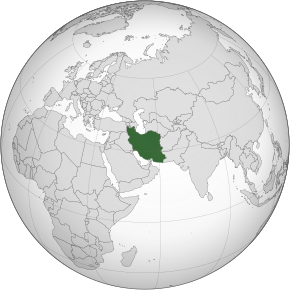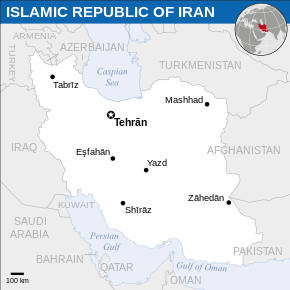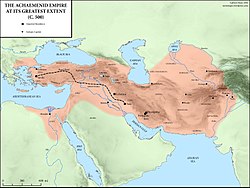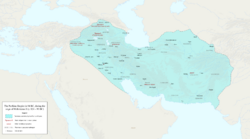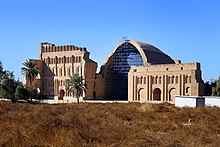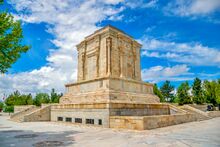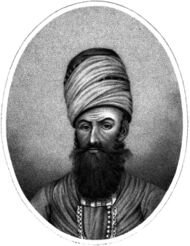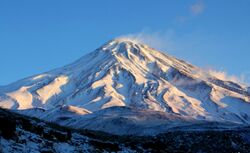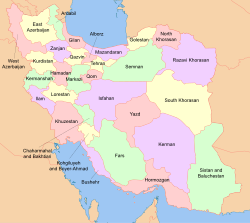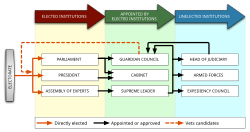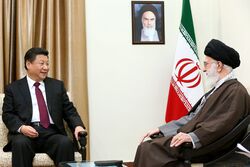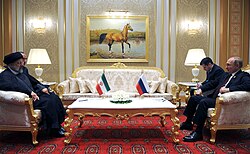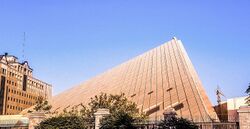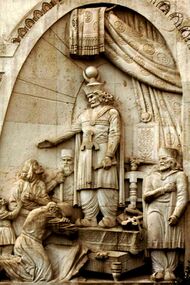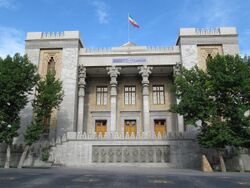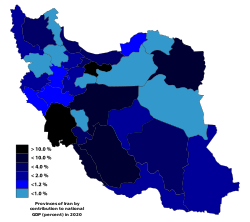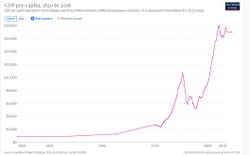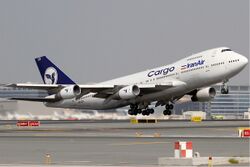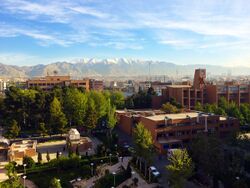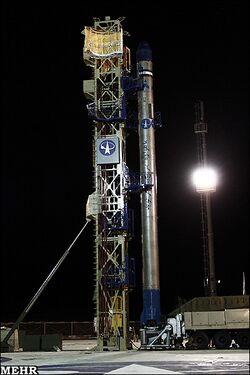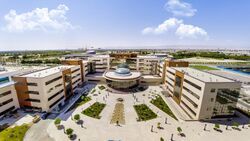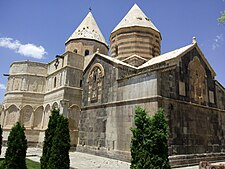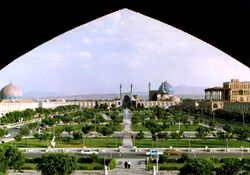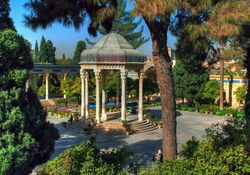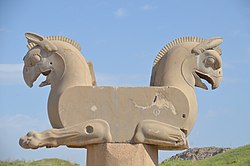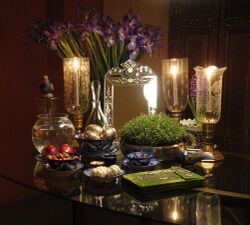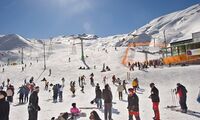Religion:Iran
This page may be too long to read and navigate comfortably. (January 2024) |
Islamic Republic of Iran | |
|---|---|
Anthem: سرود ملی جمهوری اسلامی ایران Sorud-e Melli-ye Jomhuri-ye Eslâmi-ye Irân "National Anthem of the Islamic Republic of Iran" | |
| Capital and largest city | Tehran [ ⚑ ] 35°41′N 51°25′E / 35.683°N 51.417°E |
| Official languages | Persian |
| Recognised regional languages | |
| Ethnic groups (2003 estimate)[4] | All
|
| Religion (2022)[5] |
|
| Demonym(s) | Iranian |
| Government | Unitary presidential theocratic Islamic republic |
| Ali Khamenei | |
• President | Ebrahim Raisi |
• Vice President | Mohammad Mokhber |
• Speaker of the Parliament | Mohammad Bagher Ghalibaf |
• Secretary of the Guardian Council | Ahmad Jannati |
• Chief Justice | Gholam-Hossein Mohseni-Eje'i |
| Legislature | Islamic Consultative Assembly |
| Establishment history | |
| c. 3200 BC | |
• Median Empire | c. 678 BC |
| 550 BC | |
| 247 BC | |
• Sasanian Empire | 224 AD |
• Buyid dynasty | 934 |
• Safavid Empire | 1501 |
| 1736 | |
• Zand dynasty | 1751 |
• Qajar Iran | 1796 |
• Pahlavi Iran | 15 December 1925 |
• Iranian Revolution - Constitution of Iran | 11 February 1979 – 3 December 1979 |
• Latest amendment | 28 July 1989 |
| Area | |
• Total | 1,648,195 km2 (636,372 sq mi) (17th) |
• Water (%) | 1.63 (as of 2015)[6] |
| Population | |
• 2023 estimate | 87,590,873[7] ({{{population estimate rank}}}) |
• Density | 55/km2 (142.4/sq mi) (132nd) |
| GDP (PPP) | 2023 estimate |
• Total | |
• Per capita | |
| GDP (nominal) | 2023 estimate |
• Total | |
• Per capita | |
| Gini (2019) | 40.9[9] medium |
| HDI (2021) | high · 76th |
| Currency | Iranian rial (ریال) ({{{currency code}}}) |
| Time zone | UTC+3:30 (IRST) |
| Date format | yyyy/mm/dd (SH) |
| Driving side | right |
| Calling code | +98 |
| ISO 3166 code | IR |
| Internet TLD |
|
Iran,[lower-alpha 1] also known as Persia[lower-alpha 2] and officially the Islamic Republic of Iran,[lower-alpha 3] is a country in West Asia. It is bordered by Iraq to the west and Turkey to the northwest, Azerbaijan, Armenia, the Caspian Sea and Turkmenistan to the north, Afghanistan to the east, Pakistan to the southeast, the Gulf of Oman and the Persian Gulf to the south. It covers an area of 1.648 million square kilometers (0.64 million square miles), making it the world's 17th-largest country. Iran has around 90 million people, making it the world's 17th most populous country. Its capital and largest city is Tehran and the national language is Farsi. Historically a multi-ethnic country, Iran remains a pluralistic society comprising numerous ethnic, linguistic, and religious groups, with the largest of these being the Persians, Azeris, Kurds, Mazanderanis, Lurs, Gilaks, Baluchs, Arabs and Talysh.[12]
Iran is home to one of the world's oldest civilizations, beginning with the formation of the Elamite kingdoms in the fourth millennium BC. It was first unified by the Medes in the seventh century BC and reached its territorial height in the sixth century BC, when Cyrus the Great founded the Achaemenid Empire. Alexander the Great conquered the empire in the fourth century BC, and it was subsequently divided into several Hellenistic states. An Iranian rebellion established the Parthian Empire in the third century BC, which was succeeded in the third century AD by the Sasanian Empire. Arab Muslims conquered the empire in the seventh century AD, leading to its Islamization; Iran thereafter became a major center of Islamic culture and learning. Over the next two centuries, a series of native Iranian Muslim dynasties emerged before the Seljuk and the Mongols conquered the region. In the 16th century, the native Safavids re-established a unified Iranian state. Under the reign of Nader Shah in the 18th century, Iran presided over the most powerful military in the world, though by the 19th century, a series of conflicts with the Russian Empire led to significant territorial losses. The early 20th century saw the Persian Constitutional Revolution. Efforts to nationalise its fossil fuel supply led to an Anglo-American coup in 1953. After the Iranian Revolution, the current Islamic republic was established in 1979 by Ruhollah Khomeini, who became the country's first supreme leader.
The Iranian government is an Islamic republic with a presidential system, though ultimate authority is vested in a theocratic "Rahbar"; the position has been held by Ali Khamenei since Khomeini's death in 1989. The Iranian government is authoritarian, and has attracted widespread criticism for its significant constraints and violations of human rights and civil liberties. It is also a focal point for Shia Islam within the Middle East. Since the Iranian Revolution, the country is considered to be the most determined adversary of Israel and Saudi Arabia. On March 10, 2023, Iran and Saudi Arabia normalized relations after years of hostility.[13] The Iranian government has been criticised[by whom?] for various policies such as its alleged sponsorship of terrorism, funding of proxy militias and its involvement in the majority of modern Middle Eastern conflicts.
Iran is a regional and middle power and occupies a strategic location in the Asian continent. It is a founding member of the United Nations , the ECO, the OIC, the OPEC, the SCO, and a member of BRICS.[14] It has large reserves of fossil fuels—including the second largest natural gas supply and the third-largest proven oil reserves. The country's rich cultural legacy is reflected in part by its 27 UNESCO World Heritage Sites, which ranks 10th worldwide. Iran places 5th globally in terms of Intangible Cultural Heritage.[15][16]
Etymology
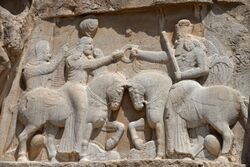
The term Iran derives from Middle Persian Ērān, first attested in a third-century inscription at Naqsh-e Rostam, with the accompanying Parthian inscription using the term Aryān, in reference to the Iranians.[18] The terms Ērān and Aryān are oblique plural forms of gentilic nouns ēr- (Middle Persian) and ary- (Parthian), both deriving from Proto-Iranian language *arya- (meaning "Aryan", i.e. "of the Iranians"),[18][19] recognised as a derivative of Proto-Indo-European language *ar-yo-, meaning "one who assembles (skilfully)".[20] According to the Iranian mythology, the country's name comes from the name of Iraj, a legendary prince and king.[21]
Historically, Iran has been referred to as Persia by the West,[22][23] due mainly to the writings of Greek historians who referred to all of Iran as Persís (Ancient Greek: Περσίς; from Old Persian 𐎱𐎠𐎼𐎿 Pârsa),[24] meaning "land of the Persians", while Persis was one of the provinces of ancient Iran.[25] The word Persia is a Greek word adopted by the West and the rest of the world that is used as an exonym and was originally used to refer to Cyrus the Great’s empire.[26]
In 1935, Reza Pahlavi requested the international community to refer to the country by its native name, Iran.[27][28] Opposition to the name change led to the reversal of the decision in 1959, and Professor Ehsan Yarshater, editor of Encyclopædia Iranica, propagated a move to use Persia and Iran interchangeably.[29] Today, both Iran and Persia are used in cultural contexts, while Iran remains mandatory in official state contexts.[30][31][32][33][34][35][page needed]
The Persian pronunciation of Iran is [ʔiːˈɾɒːn]. Common Commonwealth English pronunciations of Iran are listed in the Oxford English Dictionary as /ɪˈrɑːn/ and /ɪˈræn/,[36] while American English dictionaries such as Merriam-Webster's provide pronunciations which map to /ɪˈrɑːn, -ˈræn, aɪˈræn/,[37] or likewise in Random House Webster's Unabridged Dictionary as /ɪˈræn, ɪˈrɑːn, aɪˈræn/. The Cambridge Dictionary lists /ɪˈrɑːn/ as the British pronunciation and /ɪˈræn/ as the American pronunciation. The pronunciation guide from Voice of America also provides /ɪˈrɑːn/.[38] The American English pronunciation /aɪˈræn/ may be heard in U.S. media.
History
This section may contain an excessive amount of intricate detail that may interest only a particular audience. (January 2024) (Learn how and when to remove this template message) |
Prehistory

The earliest attested archaeological artifacts in Iran confirm a human presence in Iran since the Lower Paleolithic.[40] Iran's Neanderthal artifacts have been found mainly in the Zagros region, at sites such as Warwasi and Yafteh.[41][42][page needed][43] From the tenth to the seventh millennium BC, early agricultural communities began to flourish in and around the Zagros region in western Iran, including Chogha Golan,[44][45] Chogha Bonut,[46][47] and Chogha Mish.[48][49][page needed][50]
The occupation of grouped hamlets in the area of Susa, as determined by radiocarbon dating, ranges from 4395 to 3955 to 3680–3490 BC.[51] There are dozens of prehistoric sites across the Iranian Plateau, pointing to the existence of ancient cultures and urban settlements in the fourth millennium BC.[50][52][53] During the Bronze Age, the territory of present-day Iran was home to several civilizations,[54][55] including Elam, Jiroft, and Zayanderud. Elam, the most prominent of these civilizations, developed in the southwest alongside those in Mesopotamia, and continued its existence until the emergence of the Iranian empires. The advent of writing in Elam was paralleled to Sumer, and the Elamite cuneiform was developed since the third millennium BC.[56]
Some 8,000 years old artifacts have been unearthed in Iran's Piranshahr city. Diverse artifacts from The Bronze Age, huge structures from The Iron Age and various sites dating back to the Sassanid, Parthian and Islamic eras indicated suitable climate conditions for human civilization over the past 8,000 years in Piranshahr area.[57][58][59]
From the 34th to the 20th century BC, northwestern Iran was part of the Kura-Araxes culture, which stretched into the neighboring Caucasus and Anatolia. Since the earliest second millennium BC, Assyrians settled in swaths of western Iran and incorporated the region into their territories.
Ancient Iran
By the second millennium BC, the ancient Iranian peoples arrived in what is now Iran from the Eurasian Steppe,[60] rivaling the native settlers of the region.[61][62] As the Iranians dispersed into the wider area of Greater Iran and beyond, the boundaries of modern-day Iran were dominated by Median, Persian, and Parthian tribes.
From the late tenth to the late seventh century BC, the Iranian peoples, together with the "pre-Iranian" kingdoms, fell under the domination of the Assyrian Empire, based in northern Mesopotamia.[63][page needed] Under king Cyaxares, the Medes and Persians entered into an alliance with Babylonian ruler Nabopolassar, as well as the fellow Iranian Scythians and Cimmerians, and together they attacked the Assyrian Empire. The civil war ravaged the Assyrian Empire between 616 and 605 BC, thus freeing their respective peoples from three centuries of Assyrian rule.[63] The unification of the Median tribes under king Deioces in 728 BC led to the foundation of the Median Empire and their capital Ecbatana, which by 612 BC, controlled almost the entire territory of present-day Iran and eastern Anatolia.[64] This marked the end of the Kingdom of Urartu as well, which was subsequently conquered and dissolve[65][66]
In 550 BC, Cyrus the Great, the son of Mandane and Cambyses I, took over the Median Empire, and founded the Achaemenid Empire by unifying other city-states. Pasargadae was the capital of the Achaemenid Empire during the time of Cyrus the Great. The conquest of Media was a result of what is called the Persian Revolt. Later conquests under Cyrus and his successors expanded the empire to include Lydia, Babylon, Egypt, parts of the Balkans and Eastern Europe proper, as well as the lands to the west of the Indus and Oxus rivers. In 539 BC Persian forces defeated the Babylonian army at Opis, and marked the end of around four centuries of Mesopotamian domination of the region by conquering the Neo-Babylonian Empire.[67][68][69]
At around 518 BC, Persepolis was founded by Darius the Great as the ceremonial capital of the Achaemenid Empire. Susa and Ecbatana were the winter and summer capital of the empire, respectively. its greatest extent, the Achaemenid Empire included territories of modern-day Iran, Republic of Azerbaijan (Arran and Shirvan), Armenia, Georgia, Turkey (Anatolia), much of the Black Sea coastal regions, northeastern Greece and southern Bulgaria (Thrace), northern Greece and North Macedonia (Paeonia and Macedon), Iraq, Syria, Lebanon, Jordan, Israel and the Palestinian territories, all significant population centers of ancient Egypt as far west as Libya, Kuwait, northern Saudi Arabia, parts of the United Arab Emirates and Oman, Pakistan, Afghanistan, and much of Central Asia, making it the largest empire the world had yet seen.[68] It is estimated that in 480 BC, 50 million people lived in the Achaemenid Empire.[70][71] The empire at its peak ruled over 44% of the world's population, the highest for any empire in history.[72] The Achaemenid Empire is noted for the release of the Jewish exiles in Babylon,[73] building infrastructures such as the Royal Road and the Chapar (postal service), and the use of an official language, Imperial Aramaic.[68] The empire had a centralised, bureaucratic administration under the emperor, a large professional army, and civil services, inspiring similar developments in later empires.[74][75] Eventual conflict on the western borders began with the Ionian Revolt, which erupted into the Greco-Persian Wars and continued through the first half of the fifth century BC and ended with the withdrawal of the Achaemenids from all of the territories in the Balkans and Eastern Europe proper.[76] In 334 BC, Alexander the Great defeated the last Achaemenid emperor, Darius III, at the Battle of Issus. Following the premature death of Alexander, Iran came under the control of the Hellenistic Seleucid Empire.
In the middle of the second century BC, the Parthian Empire rose to become the main power in Iran, and the century-long geopolitical arch-rivalry between the Romans and the Parthians began, culminating in the Roman–Parthian Wars. The Parthian Empire continued as a feudal monarchy for nearly five centuries, until 224 CE, when it was succeeded by the Sasanian Empire.[77] Together with their neighboring arch-rival, the Roman-Byzantines, they made up the world's two most dominant powers at the time, for over four centuries.[78][79]
The Sasanians established an empire within the frontiers achieved by the Achaemenids, with their capital at Ctesiphon. Late antiquity is considered one of Iran's most influential periods, as under the Sasanians,[80] their influence reached the culture of ancient Rome (and through that as far as Western Europe),[81][82] Africa,[83] China, and India,[84] and played a prominent role in the formation of the medieval art of both Europe and Asia.[78][79]
Medieval period
The prolonged Byzantine–Sasanian wars, most importantly the climactic war of 602–628, as well as the social conflict within the Sasanian Empire, opened the way for an Arab invasion of Iran in the seventh century.[85][86] The empire was initially defeated by the Rashidun Caliphate, which was succeeded by the Umayyad Caliphate, followed by the Abbasid Caliphate. A prolonged and gradual process of state-imposed Islamization followed, which targeted Iran's then Zoroastrian majority and included religious persecution,[87][88][89] demolition of libraries[90] and fire temples,[91] a special tax penalty ("jizya"),[92][93] and language shift.[94][95]
In 750, the Abbasids overthrew the Umayyads.[96] Arabs Muslims and Persians of all strata made up the rebel army, which was united by the converted Persian Muslim, Abu Muslim.[97][98][99] In their struggle for power, the society in their times gradually became cosmopolitan. Persians and Turks began to replace the Arabs in most fields. The fusion of the Arab nobility with the subject races, the practice of polygamy and concubinage, made for a social amalgam wherein loyalties became uncertain, and a hierarchy of officials emerged, a bureaucracy at first Persian and later Turkish which decreased Abbasid prestige and power for good.[100]
After two centuries of Arab rule, semi-independent and independent Iranian kingdoms—including the Tahirids, Saffarids, Sajids, Samanids, Ziyarids, Buyids, Sallarids, Rawadids, Marwanids, Shaddadids, Kakuyids, Annazids and Hasanwayhids—began to appear on the fringes of the declining Abbasid Caliphate.[101] They also focused on reviving the Persian language, the most significant one was Shahnameh written by Ferdowsi.[102] Shahnameh is the national epic of Iran, and the world's longest epic poem created by a single poet.[103][104][105]
The blossoming literature, philosophy, mathematics, medicine, astronomy and art of Iran became major elements in the formation of a new age for the Iranian civilization, during a period known as the Islamic Golden Age.[106][107] The Islamic Golden Age reached its peak by the 10th and 11th centuries, during which Iran was the main theater of scientific activities.[108] The tenth century saw a mass migration of Turkic tribes from Central Asia into the Iranian Plateau.[109] Turkic tribesmen were first used in the Abbasid army as mamluks (slave-warriors).[97] As a result, the Mamluks gained significant political power. In 999, large portions of Iran came briefly under the rule of the Ghaznavids, whose rulers were of mamluk Turkic origin, and longer subsequently under the Seljuk and Khwarezmian empires.[109] The Seljuks subsequently gave rise to the Sultanate of Rum in Anatolia.[110][111] The result of the adoption and patronage of Persian culture by Turkish rulers was the development of a distinct Turco-Persian tradition.
From 1219 to 1221, under the Khwarazmian Empire, Iran suffered a devastating invasion by the Mongol Empire. According to Steven R. Ward, "Mongol violence and depredations killed up to three-fourths of the population of the Iranian Plateau, possibly 10 to 15 million people. Some historians have estimated that Iran's population did not again reach its pre-Mongol levels until the mid-20th century."[112] Most modern historians either outright dismiss or are highly skeptical of such statistics and deem them to be exaggerations by Muslim chroniclers of that era. Indeed, as far as the Iranian plateau was concerned, the bulk of the Mongol onslaught and battles were in the northeast of what is modern-day Iran, such as in the cities of Nishapur and Tus.[113][114][115]
Following the fracture of the Mongol Empire in 1256, Hulagu Khan established the Ilkhanate Empire in Iran. In 1357, the capital Tabriz was occupied by the Golden Horde khan Jani Beg and the centralised power collapsed, resulting in the emergence of rivaling dynasties. In 1370, yet another conqueror, Timur, took control over Persia, establishing the Timurid Empire. In 1387, Timur ordered the complete massacre of Isfahan, reportedly killing 70,000 citizens.[116]
Early modern period
Safavids
By the 1500s, Ismail I established the Safavid Empire,[117][118] with his capital at Tabriz.[109] Beginning with Azerbaijan, he subsequently extended his authority over all of the Iranian territories, and established an intermittent Iranian hegemony over the vast relative regions, reasserting the Iranian identity within large parts of Greater Iran.[119] Iran was predominantly Sunni,[120] but Ismail instigated a forced conversion to the Shia branch,[121][118][122][123] spreading throughout the Safavid territories in the Caucasus, Iran, Anatolia, and Mesopotamia. As a result, modern-day Iran is the only official Shia nation of the world, with it holding an absolute majority in Iran and the Republic of Azerbaijan.[124][125] The relationship between the Safavid dynasty and the West begins with the presence of the Portuguese in the Persian Gulf from the 16th century, oscillating between alliances and open war between the 17th and 18th. The Safavid era saw the start of mass integration from Caucasian populations into new layers of the society of Iran, as well as mass resettlement of them within the heartlands of Iran. Following a gradual decline in the late 1600s and the early 1700s, which was caused by internal conflicts, the continuous wars with the Ottomans, and the foreign interference (most notably Russian), the Safavid rule was ended by the Pashtun rebels who besieged Isfahan and defeated Soltan Hoseyn in 1722.
Afsharids
In 1729, Nader Shah successfully drove out and conquered the Pashtun invaders. He subsequently took back the annexed Caucasian territories which were divided among the Ottoman and Russian authorities by the ongoing chaos in Iran. During the reign of Nader Shah, Iran reached its greatest extent since the Sasanian Empire, reestablishing the Iranian hegemony all over the Caucasus, as well as other major parts of the west and central Asia, and briefly possessing what was arguably the most powerful empire at the time.[126][127][128][126]
Nader Shah invaded India and sacked Delhi by the late 1730s. His territorial expansion, as well as his military successes, went into a decline following the final campaigns in the Northern Caucasus against then revolting Lezgins. The assassination of Nader Shah sparked a brief period of civil war and turmoil, after which Karim Khan of the Zand dynasty came to power in 1750, bringing a period of relative peace and prosperity.[112]
Zands
Compared to its preceding dynasties, the geopolitical reach of the Zand dynasty was limited. Many of the Iranian territories in the Caucasus gained de facto autonomy and were locally ruled through various Caucasian khanates. However, despite the self-ruling, they all remained subjects and vassals to the Zand king. It later quickly came to expand to include much of the rest of contemporary Iran (except for the provinces of Balochistan and Khorasan) as well as parts of Iraq. The lands of present-day Armenia, Azerbaijan, and Georgia were controlled by khanates which were de jure part of the Zand realm, but the region was de facto autonomous.[129] The island of Bahrain was also held for the Zands by the autonomous Al-Mazkur sheikhdom of Bushire.[130][131] The reign of its most important ruler, Karim Khan, was marked by prosperity and peace. With its capital at Shiraz, arts and architecture flourished under Karim Khan's reign, with some themes in architecture being revived from the nearby sites of the Achaemenid and Sasanian era's of pre-Islamic Iran. Another civil war ensued after the death of Karim Khan in 1779, out of which Agha Mohammad Khan emerged, founding the Qajar dynasty in 1794.
Qajars
Agha Mohammad Khan's reign is noted for the return of a centralized and unified Iran and for relocating the capital to Tehran.[132] In 1795, following the disobedience of the Georgian subjects and their alliance with the Russians, the Qajars captured Tbilisi by the Battle of Krtsanisi, and drove the Russians out of the entire Caucasus, reestablishing the Iranian suzerainty over the region. The Russo-Iranian wars of 1804–1813 and 1826–1828 resulted in large irrevocable territorial losses for Iran in the Caucasus, comprising all of the South Caucasus and Dagestan, which made part of the very concept of Iran for centuries,[127] and thus substantial gains for the neighboring Russian Empire. As a result of the 19th-century Russo-Iranian wars, the Russians took over the Caucasus, and Iran irrevocably lost control over its integral territories in the region (comprising modern-day Dagestan, Georgia, Armenia, and Republic of Azerbaijan), which got confirmed per the treaties of Gulistan and Turkmenchay.[128][133]
The area to the north of Aras River, among which the contemporary Republic of Azerbaijan, eastern Georgia, Dagestan, and Armenia are located, were Iranian territory until they were occupied by Russia in the 19th century.[128][134][135][136][137][138][139] The weakening of Persia made it into a victim of the colonial struggle between Russia and Britain known as the Great Game.[140] Especially after the treaty of Turkmenchay, Russia was the dominant force in Iran,[141] while the Qajars would also play a role in several 'Great Game' battles such as the sieges of Herat in 1837 and 1856. As Iran shrank, many South Caucasian and North Caucasian Muslims moved towards Iran,[142][143] especially until the aftermath of the Circassian genocide,[143] and the decades afterwards, while Iran's Armenians were encouraged to settle in the newly incorporated Russian territories,[144][145][146] causing significant demographic shifts. Around 1.5 million people—20 to 25% of the population of Iran—died as a result of the Great Famine of 1870–1872.[147]
Constitutional Revolution
Between 1872 and 1905, a series of protests took place in response to the sale of concessions to foreigners by Qajar monarchs Naser-ed-Din and Mozaffar-ed-Din, and led to the Constitutional Revolution in 1905. The first Iranian constitution and the first national parliament of Iran were founded in 1906, through the ongoing revolution. The Constitution included the official recognition of Iran's three religious minorities, namely Christians, Jews, and Zoroastrians.[148] The struggle related to the constitutional movement was followed by the Triumph of Tehran in 1909, when Mohammad Ali Shah was forced to abdicate. In 1907, the Anglo-Russian Convention divided Qajar Iran into influence zones, formalising many of the concessions. On the pretext of restoring order, the Russians occupied northern Iran and the city of Tabriz and maintained a military presence in the region for years to come. But this did not put an end to the civil uprisings and was soon followed by Mirza Kuchik Khan's Jungle Movement against both the Qajar monarchy and foreign invaders.
Despite Iran's neutrality during World War I, the Ottoman, Russian, and British Empires occupied the territory of western Iran and fought the Persian campaign before fully withdrawing their forces in 1921. At least 2 million Persian civilians died either directly in the fighting, the Ottoman perpetrated anti-Christian genocides or the war-induced famine of 1917–1919. A large number of Iranian Assyrian and Iranian Armenian Christians, as well as those Muslims who tried to protect them, were victims of mass murders committed by the invading Ottoman troops.[149][150][151][152][153]
Apart from the rule of Agha Mohammad Khan, the Qajar rule is characterised as a century of misrule.[109] The inability of Qajar Iran's government to maintain the country's sovereignty during and immediately after World War I led to the British directed 1921 Persian coup d'état and Reza Shah's establishment of the Pahlavi dynasty. Reza Shah became the new Prime Minister of Iran and was declared the new monarch in 1925.
Pahlavis
In the midst of World War II, in July and August 1941 the British demanded that the Iranian government expel all Germans from Iran. Reza Shah refused to expel the Germans and on 25 August 1941, the British and Soviets launched a surprise invasion and Reza Shah's government quickly surrendered.[154] The invasion's strategic purpose was to secure a supply line to the USSR (later named the Persian Corridor), secure the oil fields and Abadan Refinery (of the UK-owned Anglo-Iranian Oil Company), prevent a German advance on Baku's oil fields, and limit German influence in Iran. Following the invasion, on 16 September 1941 Reza Shah abdicated and was replaced by Mohammad Reza Pahlavi.[155][156][157] During the rest of World War II, Iran became a major conduit for British and American aid to the Soviet Union and an avenue through which over 120,000 Polish refugees and Polish Armed Forces fled the Axis advance.[158] At the 1943 Tehran Conference, the Allied "Big Three"—Joseph Stalin , Franklin D. Roosevelt, and Winston Churchill—issued the Tehran Declaration to guarantee the post-war independence and boundaries of Iran. However, at the end of the war, Soviet troops remained in Iran and established two puppet states in north-western Iran, namely the People's Government of Azerbaijan and the Republic of Mahabad. This led to the Iran crisis of 1946, one of the first confrontations of the Cold War, which ended after oil concessions were promised to the USSR and Soviet forces withdrew from Iran proper in May 1946. The two puppet states were soon overthrown, and the oil concessions were later revoked.[159][160]
1951–1978: Mosaddegh, Mohammad Reza Pahlavi
In 1951, Mohammad Mosaddegh was elected Prime Minister of Iran, voted in by the legislature and confirmed by the Shah. Mosaddegh became enormously popular after he nationalized the oil industry of Iran, which had been largely controlled by foreign interests. He worked to weaken the monarchy of Mohammad Reza Pahlavi until Mosaddegh was removed in the 1953 Iranian coup d'état—initially an Anglo-American covert operation that marked the first time the United States had participated in an overthrow of a foreign government during the Cold War.[161]
After the coup, the Shah became increasingly autocratic and sultanistic, and Iran entered a decades-long phase of controversially close relations with the United States and other foreign governments.[162] While the Shah increasingly modernised Iran and claimed to retain it as a fully secular state,[163] arbitrary arrests and torture by his secret police, the SAVAK, were used for crushing political opposition.[164]
Ruhollah Khomeini, a radical Muslim cleric,[165] became an active critic of the Shah's reforms known as the White Revolution. Khomeini publicly denounced the government and was arrested and imprisoned for 18 months. After his release in 1964, he was eventually sent into exile.
Due to the 1973 spike in oil prices, the economy of Iran was flooded with foreign currency, which caused inflation. By 1974, the economy of Iran was experiencing a double-digit inflation rate, and despite the many large projects to modernise the country, corruption was rampant and caused large amounts of waste. By 1975 and 1976, an economic recession led to an increased unemployment rate, especially among millions of youths who had migrated to the cities of Iran looking for construction jobs during the boom years of the early 1970s. By the late 1970s, many of these people opposed the Shah's regime and began organizing and joining the protests against it.[166]
Iranian Revolution
The 1979 Iranian Revolution, later known as the Islamic Revolution,[167][168][169][170][163][171] began in January 1978 with the first major demonstrations against the Mohammad-Reza Pahlavi.[172] After a year of strikes and demonstrations paralyzing the country and its economy, Mohammad Reza Pahlavi fled to the United States, and Ruhollah Khomeini returned from exile to Tehran in February 1979, forming a new government.[173] After holding a referendum, Iran officially became an Islamic republic in April 1979.[174] A second referendum in December 1979 approved a theocratic constitution.[175]
Immediate nationwide uprisings against the new government began with the 1979 Kurdish rebellion and the Khuzestan uprisings, along with uprisings in Sistan and Baluchestan and other areas. Over the next several years, these uprisings were subdued violently by the new government. The new government began purging itself of the non-Islamist political opposition, as well as Islamists who were not considered radical enough. Although both nationalists and Marxists had initially joined with Islamists to overthrow the Shah, tens of thousands were executed by the new regime.[176] Following Khomeini's order to purge the new government of any remaining officials still loyal to the exiled Shah, many former ministers and officials in the Shah's government, including former prime minister Amir-Abbas Hoveyda, were executed.
On 4 November 1979, after the United States refused the extradition of Mohammad Reza Pahlavi, a group of Muslim students seized the United States Embassy and took the embassy with 52 personnel and citizens hostage.[177] Attempts by the Jimmy Carter administration to negotiate for the release of the hostages, and a failed rescue attempt, helped with the falling popularity of Carter among US citizens and brought Ronald Reagan to power. On Jimmy Carter's final day in office, the last hostages were set free due to the Algiers Accords.
The Cultural Revolution began in 1980, with threats to close universities which did not conform to Islamization demands from the new government. All universities in the country were closed down in 1980, and reopened in 1983.[178][179][180]
On 22 September 1980, the Iraqi army invaded the western Iranian province of Khuzestan, initiating the Iran–Iraq War. Although the forces of Saddam Hussein made several early advances, by mid-1982, the Iranian forces successfully managed to drive the Iraqi army back into Iraq. In July 1982, Iran decided to invade Iraq and conducted offensives to conquer Iraqi territory and capture cities, such as Basra. The war continued until 1988, when the Iraqi army defeated the Iranian forces inside Iraq and pushed the remaining Iranian troops back across the border. Subsequently, Khomeini accepted a truce mediated by the United Nations. The total Iranian casualties in the war were estimated to be 123,220–160,000 KIA, 60,711 MIA, and 11,000–16,000 civilians killed.[181][182]
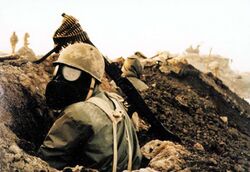
Following the Iran–Iraq War, in 1989, Akbar Hashemi Rafsanjani concentrated on a pragmatic pro-business policy of rebuilding and strengthening the economy without making any dramatic break with the ideology of the revolution. In 1997, Rafsanjani was succeeded by moderate reformist Mohammad Khatami, whose government attempted, unsuccessfully, to make the country freer and more democratic.[183]
The 2005 presidential election brought conservative populist candidate, Mahmoud Ahmadinejad, to power.[184] By the time of the 2009 Iranian presidential election, the Interior Ministry announced incumbent President Ahmadinejad had won 62.63% of the vote.[185][186] The election results were widely disputed,[187][188] and resulted in widespread protests[189][190] and the creation of the Iranian Green Movement.
Hassan Rouhani was elected as the president on 15 June 2013.[191][192] The electoral victory of Rouhani relatively improved the relations of Iran with other countries.[193] The 2017–18 Iranian protests swept across the country in response to the economic and political situation.[194] The scale of protests throughout the country and the number of people participating were significant,[195] and it was formally confirmed that thousands of protesters were arrested.[196] The 2019–20 Iranian protests started on 15 November in Ahvaz, spreading across the country within hours, after the government announced increases in the fuel price of up to 300%.[197] A week-long total Internet shutdown throughout the country marked one of the most severe Internet blackouts in any country, and in the bloodiest governmental crackdown of the protestors in the history of Islamic Republic;[198] tens of thousands were arrested and hundreds were killed within a few days according to multiple international observers, including Amnesty International.[199] On 3 January 2020, the revolutionary guard's general, Qasem Soleimani, was assassinated by the United States in Iraq, which considerably heightened the existing tensions between the two countries.[200] His assassination lead to Operation Martyr Soleimani, the largest ballistic missile attack ever on Americans.[201] The BBC reported that millions of mourners gathered in Soleimani's funeral ceremony on 6 January.[202] Three days after, Iran's Islamic Revolutionary Guard Corps launched a retaliatory attack on US forces in Iraq and shot down Ukraine International Airlines Flight 752, killing all members on board the plane and leading to nation-wide protests. An international investigation led to the government admitting to the shootdown, calling it a "human error".[203][204]
Protests against the government began on 16 September 2022 after a woman named Mahsa Amini died in police custody after being arrested by the country's Guidance Patrol,[205][206][207] known commonly as the "morality police".[208]
On January 15, 2024, Iran launched ballistic missile and drone attacks against alleged Mossad headquarters in Iraqi Kurdistan,[209][210][211] and ISIS bases in northern Syria,[212][213][214] in response to the killing of Razi Mousavi and 2024 Kerman bombings.[215][216][213] As one of Iran's most extensive operations, the attack caused significant collateral damage in Erbil.[217][218][219] A day after the attack in Iraq and Syria, Iran carried out a similar series of strikes in Panjgur District of Pakistan , targeting the Sunni terror group Jaish ul-Adl.[220][221][215]
Geography
Iran has an area of 1,648,195 km2 (636,372 sq mi).[3] It is the fourth-largest country entirely in Asia and the second-largest country in West Asia behind Saudi Arabia.[222] It lies between latitudes 24° and 40° N, and longitudes 44° and 64° E. It is bordered to the northwest by Armenia (35 km or 22 mi), the Azeri exclave of Nakhchivan (179 km or 111 mi),[223] and the Republic of Azerbaijan (611 km or 380 mi); to the north by the Caspian Sea; to the northeast by Turkmenistan (992 km or 616 mi); to the east by Afghanistan (936 km or 582 mi) and Pakistan (909 km or 565 mi); to the south by the Persian Gulf and the Gulf of Oman; and to the west by Iraq (1,458 km or 906 mi) and Turkey (499 km or 310 mi).
Iran is in a seismically active area.[224] On average, an earthquake of magnitude seven on the Richter scale occurs once every ten years.[225] Most earthquakes are shallow-focus and can be very devastating, such as the 2003 Bam earthquake.
Iran consists of the Iranian Plateau, with the exception of the coasts of the Caspian Sea and Khuzestan. It is one of the world's most mountainous countries, its landscape dominated by rugged mountain ranges that separate various basins or plateaus from one another. The populous western part is the most mountainous, with ranges such as the Caucasus, Zagros, and Alborz, the last containing Mount Damavand, Iran's highest point at 5,610 m (18,406 ft), which is also the highest mountain in Asia west of the Hindu Kush.[226]
The northern part of Iran is covered by the lush lowland Caspian Hyrcanian mixed forests, near the southern shores of the Caspian Sea. The eastern part consists mostly of desert basins, such as the Kavir Desert, which is the country's largest desert, and the Lut Desert, as well as some salt lakes. The Lut Desert is the hottest recorded spot on the Earth's surface according to NASA, with 70.7 °C recorded in 2005.[227][228][229][230] The only large plains are found along the coast of the Caspian Sea and at the northern end of the Persian Gulf, where the country borders the mouth of the Arvand river. Smaller, discontinuous plains are found along the remaining coast of the Persian Gulf, the Strait of Hormuz, and the Gulf of Oman.[231][232][233]
Islands
Iranian islands are mainly located in the Persian Gulf. Iran has 102 islands in Urmia Lake, 427 islands in Aras River, several islands in Anzali Lagoon, Ashurade Island in the Caspian Sea, Sheytan Island in the Oman Sea and several other inland islands. More than 40 Iranian islands in the Persian Gulf are located in the political sphere of the three provinces of Bushehr, Khuzestan and Hormozgan, more than half of which are uninhabited. Iran also has an uninhabited island at the far end of the Gulf of Oman, near the Pakistan . A small number of Iranian islands can be visited by tourists, as most of them are in the possession of the military or wildlife protection, and entry to them is generally prohibited or requires a permit.[234][235][236]
Iran took control of Bumusa, and the Greater and Lesser Tunbs in 1971, all located in the Strait of Hormuz between the Persian Gulf and the Gulf of Oman. Despite the islands being small and having little natural resources or population, they are highly valuable for their key strategic location in the Strait of Hormuz, the most vital waterway in the world.[237][238][239][240][241][242] Although the United Arab Emirates claims sovereignty over them,[243][244][245][246] it has constantly been met with strong response from the Iranian government,[247][248][249] based on their historical and cultural background dating to Achaemenid, Parthian and Sasanian Empires.[250] Iran has the full-control over the islands, and are administered as part of the Hormozgan Province.[251][252]
Kish island, as a free trade zone, is touted as a consumer's paradise, with numerous malls, shopping centers, tourist attractions, and luxury hotels. Qeshm is the largest island in Iran, and a UNESCO Global Geopark since 2016.[253][254][255] Its salt cave, "Namakdan", is the largest salt cave in the world[256][257] and one of the world's longest caves.[258][259]
Climate
Iran's climate is diverse, ranging from arid and semi-arid, to subtropical along the Caspian coast and the northern forests.[260] On the northern edge of the country (the Caspian coastal plain), temperatures rarely fall below freezing and the area remains humid for the rest of the year. Summer temperatures rarely exceed 29 °C (84.2 °F).[261][262] Annual precipitation is 680 mm (26.8 in) in the eastern part of the plain and more than 1,700 mm (66.9 in) in the western part. Gary Lewis, the United Nations Resident Coordinator for Iran, has said that "Water scarcity poses the most severe human security challenge in Iran today".[263]
To the west, settlements in the Zagros basin experience lower temperatures, severe winters with below zero average daily temperatures and heavy snowfall. The eastern and central basins are arid, with less than 200 mm (7.9 in) of rain and have occasional deserts.[264] Average summer temperatures rarely exceed 38 °C (100.4 °F).[261] The coastal plains of the Persian Gulf and Gulf of Oman in southern Iran have mild winters, and very humid and hot summers. The annual precipitation ranges from 135 to 355 mm (5.3 to 14.0 in).[261]
Iran is the largest of the few countries in the world which have not ratified the Paris Agreement.[265]
Wildlife
The wildlife of Iran includes bears, the Eurasian lynx, foxes, gazelles, gray wolves, jackals, panthers, and wild pigs.[266][267] Eagles, falcons, partridges, pheasants, and storks are also native to Iran.
One of the most famous species of animal is the critically endangered Asiatic cheetah, also known as the Iranian cheetah, whose numbers were greatly reduced after the 1979 Revolution.[268] The Persian leopard, which is the world's largest leopard subspecies and lives primarily in northern Iran, is also endangered.[269] Iran lost all its Asiatic lions and the now extinct Caspian tigers by the earlier part of the 20th century.[270]
At least 74 species of Iranian wildlife are on the red list of the International Union for Conservation of Nature. The Iranian Parliament has been showing disregard for wildlife by passing laws and regulations such as the act that lets the Ministry of Industries and Mines exploit mines without the involvement of the Department of Environment, and by approving large national development projects without demanding comprehensive study of their impact on wildlife habitats.[271]
Administrative divisions
Iran is divided into five regions with 31 provinces (ostān, استان),[272] each governed by an appointed governor (ostāndār, استاندار). The provinces are divided into counties (šahrestān, شهرستان), and subdivided into districts (baxš, بخش) and sub-districts (dehestān, دهستان).
The country has one of the highest urban growth rates in the world. From 1950 to 2002, the urban proportion of the population increased from 27% to 60%.[273] Iran's population is concentrated in its western half, especially in the north, north-west and west of the country.[274]
Tehran, with a population of around 8.8 million (2016 census), is Iran's capital and largest city. It is an economical and cultural center and is the hub of the country's communication and transport network. It is also home to the world's largest shopping mall, Iran Mall.[275][276][277][278][279][280]
The country's second most populous city, Mashhad, has a population of around 3.3 million (2016 census), and is capital of the province of Razavi Khorasan. Being the site of the Imam Reza shrine, it is a holy city in Shia Islam. About 15 to 20 million pilgrims visit the shrine every year.[281][282] Isfahan has a population of around 2.2 million (2016 census) and is Iran's third most populous city. It is the capital of Isfahan province and was also the third capital of the Safavid Empire. It is home to a wide variety of historical sites, including the famous Naqsh-e Jahan Square, Siosepol, and the churches at the Armenian district of New Julfa. It is also home to one of the world's largest shopping malls, Isfahan City Center.[283][284][285]
Government and politics
The political system of the Islamic Republic is based on the 1979 Constitution.[286] Juan José Linz wrote in 2000 that "it is difficult to fit the Iranian regime into the existing typology, as it combines the ideological bent of totalitarianism with the limited pluralism of authoritarianism and holds regular elections in which candidates advocating differing policies and incumbents are often defeated".[287] Iran ranked 154th in the 2022 The Economist Democracy Index.[288]
Supreme Leader
The Supreme Leader ("Rahbar"), or Leader of the Revolution[289] is the head of state of Iran and is responsible for delineation and supervision of policy.[290] The Iranian president has limited power compared to the Rahbar Khamenei.[291] The current longtime Rahbar is Ali Khamenei.[292][293][294] Key ministers are selected with the Rahbar Ali Khamenei's agreement and he has the ultimate say on Iran's foreign policy.[291] The Rahbar is directly involved in ministerial appointments for Defense, Intelligence and Foreign Affairs, as well as other top ministries after submission of candidates from the president.[295] Iran's regional policy is directly controlled by the office of the Rahbar with the Ministry of Foreign Affairs' task limited to protocol and ceremonial occasions. All of Iran's ambassadors to Arab countries, for example, are chosen by the Quds Corps, which directly reports to the Rahbar.[292] The Rahbar can also order laws to be amended.[296] Setad is estimated at $95 billion in 2013 by Reuters, accounts of which are secret even to the Iranian parliament.[297][298]
The Rahbar is the commander-in-chief of the armed forces, controls the military intelligence and security operations, and has sole power to declare war or peace.[290] The heads of the judiciary, the state radio and television networks, the commanders of the police and military forces, and six of the twelve members of the Guardian Council are directly appointed by the Rahbar.[290]
The Assembly of Experts is responsible for electing the Rahbar, and has the power to dismiss him on the basis of qualifications and popular esteem.[299] To date, the Assembly of Experts has not challenged any of the Rahbar's decisions nor attempted to dismiss him.[300] The previous head of the judicial system, Sadeq Larijani, appointed by the Rahbar, said that it is illegal for the Assembly of Experts to supervise the Rahbar.[301] Many believe the Assembly of Experts has become a ceremonial body without any real power.[302][303][304] There have been instances when the current Rahbar publicly criticised members of the Assembly of Experts, resulting in their arrest and dismissal.
Guardian Council
Presidential candidates and parliamentary candidates must be approved by the Guardian Council (all members of which are directly or indirectly appointed by the Leader) or the Leader before running to ensure their allegiance.[305] The Leader very rarely does the vetting himself directly but has the power to do so, in which case additional approval of the Guardian Council would not be needed. The Leader can also revert the decisions of the Guardian Council.[306] The Guardian Council can and has dismissed elected members of the Iranian parliament in the past.[307][308]
President
After the Rahbar, the Constitution defines the president of Iran as the highest state authority.[290][309] The President is elected by universal suffrage for a term of four years, but is required to gain the Leader's official approval before being sworn in before the Parliament (Majlis). The Leader also has the power to dismiss the elected president.[310] The President can only be re-elected for one term.[309]
The President is responsible for the implementation of the constitution, and for the exercise of executive powers in implementing the decrees and general policies as outlined by the Rahbar, except for matters directly related to the Rahbar, who has the final say in all matters.[290] Chapter IX of the Constitution of the Islamic Republic of Iran sets forth the qualifications for presidential candidates. The procedures for presidential election and all other elections in Iran are outlined by the Rahbar.[311] The President functions as the executive of affairs such as signing treaties and other international agreements, and administering national planning, budget, and state employment affairs, all as approved by the Rahbar.[312][313][294]
The President appoints the ministers, subject to the approval of the Parliament, as well as the approval of the Rahbar, who can dismiss or reinstate any of the ministers at any time, regardless of the decisions made by the President or the Parliament.[314][315][316] The President supervises the Council of Ministers, coordinates government decisions, and selects government policies to be placed before the legislature.[317] The current Rahbar, Ali Khamenei, has fired as well as reinstated Council of Ministers members.[318][319] Eight Vice Presidents serve under the President, as well as a cabinet of twenty-two ministers, who must all be approved by the legislature.[320]
Legislature
The legislature of Iran, known as the Islamic Consultative Assembly, is a unicameral body comprising 290 members elected for four-year terms.[321] It drafts legislation, ratifies international treaties, and approves the national budget. All parliamentary candidates and all legislation from the assembly must be approved by the Guardian Council.[322]
The Guardian Council comprises twelve jurists, including six appointed by the Rahbar. Others are elected by the Parliament, from among the jurists nominated by the Head of the Judiciary.[323][324] The Council interprets the constitution and may veto the Parliament. If a law is deemed incompatible with the constitution or Sharia (Islamic law), it is referred back to the Parliament for revision.[309] The Expediency Council has the authority to mediate disputes between the Parliament and the Guardian Council, and serves as an advisory body to the Rahbar, making it one of the most powerful governing bodies in the country.[325] Local city councils are elected by public vote to four-year terms in all cities and villages of Iran.
Law
The Rahbar appoints the head of the country's judiciary, appointing the head of the Supreme Court and the chief public prosecutor.[300] There are several types of courts, including public courts that deal with civil and criminal cases, and revolutionary courts which deal with certain categories of offenses, such as crimes against national security. The decisions of the revolutionary courts are final and cannot be appealed.[300]
The Chief Justice of Iran is the head of the Judicial system of the Islamic Republic of Iran and is responsible for its administration and supervision. He is also the highest judge of the Supreme Court of Iran. The Rahbar of Iran appoints and can dismiss the Chief Justice. The Chief Justice nominates some candidates for serving as minister of justice, and then the President select one of them. The Chief Justice can serve for two five-year terms.[326]
The Special Clerical Court handles crimes allegedly committed by clerics, although it has also taken on cases involving laypeople. The Special Clerical Court functions independently of the regular judicial framework and is accountable only to the Rahbar. The Court's rulings are final and cannot be appealed.[300] The Assembly of Experts, which meets for one week annually, comprises 86 "virtuous and learned" clerics elected by adult suffrage for eight-year terms.
Foreign relations
Since the time of the 1979 Revolution, Iran's foreign relations have often been portrayed as being based on two strategic principles: eliminating outside influences in its region and pursuing extensive diplomatic contacts with developing and non-aligned countries.[327]
Since 2005, Iran's nuclear program has become the subject of contention with the international community, mainly the United States. Many countries have expressed concern that Iran's nuclear program could divert civilian nuclear technology into a weapons program. This has led the United Nations Security Council to impose sanctions against Iran which had further isolated Iran politically and economically from the rest of the global community. In 2009, the U.S. Director of National Intelligence said that Iran, if choosing to, would not be able to develop a nuclear weapon until 2013.[328]
(As of 2009), the government of Iran maintains diplomatic relations with 99 members of the United Nations,[329] but not with the United States, and not with Israel—a state which Iran's government has derecognised since the 1979 Revolution.[330] Among Muslim nations, Iran has an adversarial relationship with Saudi Arabia due to different political and Islamic ideologies.[331] Regarding the Israeli–Palestinian conflict, the government of Iran has recognised Jerusalem as the capital of the State of Palestine, after Trump recognised Jerusalem as the capital of Israel.[332][333][334]
Since the 2000s, Iran's controversial nuclear program has raised concerns, which is part of the basis of the international sanctions against the country. On 14 July 2015, Iran and the P5+1 agreed to the Joint Comprehensive Plan on Action (JCPOA), aiming to end economic sanctions in exchange for Iran's restriction in producing enriched uranium after demonstrating a peaceful nuclear research project that would meet the International Atomic Energy Agency standards.[335]
Iran is a member of dozens of international organizations, including the G-15, G-24, G-77, IAEA, IBRD, IDA, IDB, IFC, ILO, IMF, IMO, Interpol, OIC, OPEC,[336] WHO, and the United Nations , and currently has observer status at the World Trade Organization.
Military
Iran is fast approaching to become a nuclear-power state, and has uranium enriched to up to 60% fissile content as of November 2023, close to weapon grade.[337][338][339] Iran has been seeking nuclear weapons for decades, a program which the US and other Western nations have vowed to stop, imposing economic sanctions in an attempt to do so.[340][341][342] In January 2024, the chief of the IAEA said that Iran has sufficient quantities of highly enriched uranium to build several nuclear warheads,[343][344][345][346] with some analysts already regard the country as a de facto nuclear power.[347] The country's ballistic missile, space, and nuclear programs are internationally hot political topics.[348] Iran is one of the five countries in the world that has cyber-army capabilities, making the country a major player in terms of cyber-warfare operations.[349][350][351]
Iran possesses the world's 17th strongest military.[352][353] The Islamic Republic of Iran Armed Forces, or Artesh in Persian language, ranks 13th globally in terms of military strength.[354] It is the 9th largest ground force in the world, the 9th largest armoured force globally and possesses the biggest Army Aviation fleet in the Middle East.[355] It is also the largest Armed forces in West Asia.[356][357] Iran ranks 7th globally in terms of active military personnel.[354]
The Islamic Republic of Iran Armed Forces has several components: the regular forces of the Army, which includes the Ground Forces, the Air Defense Force, the Islamic Republic of Iran Air Force , and the Navy, and the Islamic Revolutionary Guard Corps (IRGC), totaling about 610,000 active troops. Iran also has around 350,000 Reserve Force, totaling around 960,000 trained troops.[358] These numbers do not include Law Enforcement Command or Basij. While the regular army protects the country's sovereignty in a traditional capacity, the IRGC's mandate is to ensure the integrity of the Islamic Republic.[359]
All young men who reach the age of 18 must spend about two years of compulsory military service in the Iranian army, or the Islamic Revolutionary Guard Corps.[360] As of October 2023, Iran has reduced the compulsory military service for all conscripts by 3 months.[361]
Iran has a paramilitary, volunteer militia force within the IRGC, called the Basij, which includes about 90,000 full-time, active-duty uniformed members.[362] Up to 25 million men and women are members of the Basij,[363] with over 600,000 available for immediate call-up, 300,000 reservists, and some 1 million that could be mobilized when necessary.[364] In 2021, Iran's military spending increased for the first time in four years, to $24.6 billion, 2.30% of country's GDP.[365] Funding for the Islamic Revolutionary Guard Corps accounted for %34 of Iran's total military spending in 2021.[366] Iran is among the world's top 15 countries in terms of military budget.[367]
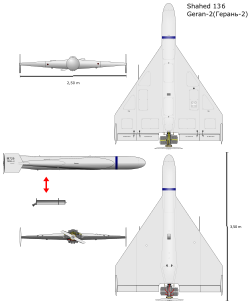
Iran has significant influence and foothold in countries such as Iraq, Syria, Yemen and Lebanon.[368][369][370][371] The government of Iran supports the military activities of its allies in Syria, Iraq, and Lebanon (Hezbollah) with military and financial aid.[372] Iran and Syria are close strategic allies, and Iran has provided significant support for the Syrian Government in the Syrian civil war.[373] According to some estimates, Iran controlled over 80,000 pro-Assad Shi'ite fighters in Syria.[373][374] Since the 1979 Revolution, to overcome foreign embargoes, the government of Iran has developed its own military industry, produced its own tanks, armored personnel carriers, missiles, submarines, military vessels, missile destroyer, radar systems, helicopters, navies and fighter planes.[375] The Iranian Navy has considerable presence in the Atlantic,[376][377][378][379] Pacific [380][381][382][383] and Indian Ocean,[384][385][386][387] and is expanding to Antarctica, namely South Pole.[388][389][390][391][392] It also has had several joint exercises with Russia and China , which aims to do annually.[393][394][395][396][397]
In recent years, official announcements have highlighted the development of weapons such as the Hoot, Kowsar, Zelzal, Fateh-110, Shahab-3, Sejjil, Fattah, Khorramahahr, Kheibar Shekan, Emad, Ghadr-110, Hormuz-1, Dezful, Qiam 1, Ashoura, Fajr-3, Haj Qasem, Persian Gulf, Raad-500, Zolfaghar, Hoveyzeh, Soumar, Fakour-90, Paveh, Rezvan, Samen, Tondar-69 and a variety of unmanned aerial vehicles (UAVs).[398] Iran has the largest and most diverse ballistic missile arsenal in the Middle East.[399] Iran is considered as a global leader and superpower in terms of drone warfare.[400][401] Iran is the 5th country in the world with hypersonic missile technology, alongside Russia , China , United States and North Korea.[402]
Regional influence
Since the 1979 Revolution, Iran has grew its influence across and beyond the region.[416][417][418][419][420] It has built military forces with a wide network of state and none-state actors, starting with Hezbollah in Lebanon in 1982.[421][422][423] Since its establishment as a primary branch to the Iranian Army, the IRGC has been key to grow the Iranian influence, by providing money, tech, and training to its Quds Force.[424][425][426][427][428] The instability in Lebanon (from the 1980s),[429] Iraq (from 2003) [430] and Yemen (from 2014) [431] have allowed Iran to build strong alliances and foothold beyond its borders. Hezbollah maintains a separate military force in Lebanon and provides numerous services to the Lebanese population, including infrastructure, health care, schools, and youth programs,[427] while also simultaneously being part of the government's political system, with representatives in the parliament and having tremendous influence over the direction and stability of Lebanon.[432][433][434][435] Hezbollah has often been regarded as a state within a state,[436] its political position and services such as education, shows its integration into the Lebanese political system and society. Its participation in the Syrian Civil War have also strengthened its military capabilities.[437][438][439][440][441] Iranian influence in Lebanon dates back to the 16th century in the Safavid Empire,[442][443] and has grown considerably during the 20th century, first minimally during the Pahlavi period,[444] and significantly after the Iranian Revolution.[445] Iran has a prominent influence in the social services, education, economy and the politics of Lebanon,[437][446] with analysts have argued that Lebanon provides Iran access to the Mediterranean Sea.[447][448] Hezbollah's strategic successes against Israel, such as its symbolic victory during the 2006 Israel–Hezbollah War, elevated Iran's influence in Levant and strengthened its appeal across the Arab World.[449][450][451]
Since the US invasion of Iraq in 2003 and the arrival of ISIS in the mid-2010s, Iran has financed and trained militia groups in Iraq, now standing as a separate force to the Iraqi military.[452][453][453][454] Since the Iran-Iraq war in 1980s, Iran has shaped Iraq's politics.[455][456][457] Iranian influence in Iraq has been advanced through the support of Shia militias since 2003.[458][459] With the loss of territory in Iraq, the militia groups were able to significantly expand in the mid-2010s.[460] Following Iraq's struggle against the ISIS in 2014, companies linked to the IRGC such as Khatam al-Anbiya, started to build roads, power plants, hotels and businesses in Basra, Nasiriyah, Najaf, Karbala and Baghdad, creating an economic corridor worth around $9 billion before the COVID-19.[461] This number is expected to grow to $20 billion in the coming years.[462][463][463]
During Yemen's civil war, Iran provided military support to the Houthis,[464][465][466][467] a Zaydi Shiite movement that has been fighting Yemen's Sunni government since 2004. Over the years, they have gained significant power and influence amid the ongoing civil war in Yemen.[468][469]
In Syria, Iran has supported President Bashar al-Assad,[449][470][471][472] with the two countries being long-standing allies and backing Hezbollah in Lebanon.[473][449] Iran has provided significant military and economic support to Assad's government,[470][474] and as a result, it has a considerable foothold in Syria, with Assad as a dominant position remaining in power.[475][476] Iran also has substantial economic, political, cultural, and religious leverage on Afghanistan.[477][478][479][480] Iran have long supported the anti-Israel fronts in North Africa in countries like Algeria and Tunisia, embracing Hamas in part to help undermine the popularity of the Palestinian Liberation Organization (PLO) in North Africa.[481] Iran's support of Hamas emerged more clearly in later years.[482][483][484][485]
Iran's influence is not only in their civilian bodies, but also in their security and intelligence. This has led the capitals of these countries, Beirut, Baghdad, Sana'a and Damascus, to be portrayed in the regional media as “Iran’s four Arab capitals”.[486][487][488][489][490] While Iran may work closely with these state and none-state groups and have significant influence on their soil, they are autonomous, and it does not translate into outright control by Iran.[491][491][492]
Human rights
UN Special Rapporteur Javaid Rehman has reported of several ethnic minorities in Iran facing discrimination.[493] A group of United Nations experts in August 2022 urged Iran to stop "systematic persecution" of religious minorities, adding that members of the Baháʼí Faith were arrested, barred from university enrolment, or had their homes demolished.[494][495] USCIRF Chair Nury Turkel in January 2023 noted that there was repression of Sunni Muslims, Gonabadi Sufi Muslims, Christians and Yarsanis in the country.[496]
Over the past decade, numbers of anti-government protests have broken out throughout Iran (such as the 2019–20 Iranian protests), demanding reforms or the end to the Islamic Republic. However, the Islamic Revolutionary Guard Corps (IRGC) and police often suppressed mass protests violently, resulting in thousands of protesters being killed.
Censorship
Censorship in Iran under the government of the Islamic Republic was ranked among the most extreme worldwide.[497][498][499] Iran also has strict regulations when it comes to internet censorship,[500] with the government and the IRGC persistently blocking social media and other websites.[501][502][503] In January 2021, Iranian authorities added Signal to the list of blocked social media platforms, which included Facebook, Telegram, Twitter and YouTube. They carried out arbitrary arrests for social media postings deemed "counter-revolutionary" or "un-Islamic".[504]
Economy
Iran's economy is a mixture of central planning, state ownership of oil and other large enterprises, village agriculture, and small-scale private trading and service ventures.[505] In 2022, Iran's nominal GDP was $352.2 billion, while its nominal GDP per capita was $4,110.[506] Iran is ranked as a lower-middle income economy by the World Bank.[507] In the early 21st century, the service sector contributed the largest percentage of the GDP, followed by industry (mining and manufacturing) and agriculture.[508]
The Central Bank of Iran is responsible for developing and maintaining the Iranian rial, the country's currency. The government does not recognise trade unions other than the Islamic labour councils, which are subject to the approval of employers and the security services.[509] The minimum wage in June 2013 was 487 million rials a month ($134).[510] Unemployment has remained above 10% since 1997, and the unemployment rate for women is almost double that of the men.[510]
In 2006, about 45% of the government's budget came from oil and natural gas revenues, and 31% came from taxes and fees.[511] (As of 2007), Iran had earned $70 billion in foreign-exchange reserves, mostly (80%) from crude oil exports.[512] Iranian budget deficits have been a chronic problem, mostly due to large-scale state subsidies, that include foodstuffs and especially gasoline, totaling more than $84 billion in 2008 for the energy sector alone.[513][514] In 2010, the economic reform plan was approved by parliament to cut subsidies gradually and replace them with targeted social assistance. The objective is to move towards free market prices in a five-year period and increase productivity and social justice.[515]
The administration continues to follow the market reform plans of the previous one, and indicates that it will diversify Iran's oil-reliant economy. Iran has also developed a biotechnology, nanotechnology, and pharmaceutical industry.[516] However, nationalised industries such as the bonyads have often been managed badly, making them ineffective and uncompetitive. Currently, the government is trying to privatise these industries, and, despite successes, there are still several problems to overcome, such as the lagging corruption in the public sector and lack of competitiveness.
Iran has leading manufacturing industries in the fields of automobile manufacture, transportation, construction materials, home appliances, food and agricultural goods, armaments, pharmaceuticals, information technology, and petrochemicals in the Middle East.[517] According to 2012 data from the Food and Agriculture Organization, Iran has been among the world's top five producers of apricots, cherries, sour cherries, cucumbers and gherkins, dates, eggplants, figs, pistachios, quinces, walnuts, and watermelons.[518]
Economic sanctions against Iran have damaged the economy.[519] In 2015, Iran and the P5+1 reached a deal on the nuclear program that removed the main sanctions pertaining to Iran's nuclear program by 2016.[520] According to the BBC, renewed U.S. sanctions against Iran "have led to a sharp downturn in Iran's economy, pushing the value of its currency to record lows, quadrupling its annual inflation rate, driving away foreign investors, and triggering protests".[521]
Tourism
Although tourism declined significantly during the war with Iraq, it has been subsequently recovered.[525] About 2.3 million foreign tourists visited Iran in 2009, mostly from Asian countries, including the republics of Central Asia, while about 10% came from the European Union and North America.[526][527] Since the removal of some sanctions against Iran in 2015, tourism has re-surged in the country. Over 5 million tourists visited Iran in the fiscal year of 2014–2015, four percent more than the previous year.[528][529]
Alongside the capital, the most popular tourist destinations are Isfahan, Shiraz and Mashhad.[530] Iran has millions of medical tourists every year, fast emerging as a preferred destination for medical tourism.[531][532] Iran's tourism had constantly been growing before the COVID-19 pandemic, reaching nearly 9 million visitors in 2019, the world's third fastest-growing tourism destination before the pandemic.[533][534] Iran's tourism experienced a growth of 48.5% in 2023, attracting over 5.2 million visitors, but 37% lower compared to the pre-COVID statistics in 2019.[535] Over 400,000 visitors motivated by trade, medical treatment and pilgrimage.[536][537][538] In September and October 2023, Iran achieved a positive balance compared to the same statistics and period in 2019.[535]
1.8 million visitors from West Asia traveled to Iran in the first seven months of 2023, a 31% growth compared to the same period in 2022. This growth surpassed that of Bahrain, Kuwait, Iraq, and Saudi Arabia.[539]
Domestic tourism in Iran is one of the largest in the world, with the Iranian tourists spent $33.3 billion in 2021.[540][541][542][543] Iran projects investment of over $32 billion in the country's tourism sector and targets 20 million tourists by 2025.[544]
Agriculture

Roughly one-third of Iran's total surface area is suited for farmland, but because of poor soil and lack of adequate water distribution in many areas, most of it is not under cultivation. Only 12% of the total land area is under cultivation (arable land, orchards and vineyards) but less than one-third of the cultivated area is irrigated; the rest is devoted to dryland farming. Some 92 percent of agricultural products depend on water.[545] The western and northwestern portions of the country have the most fertile soils. Iran's food security index stands at around 96 percent.[546] At the end of the 20th century, agricultural activities accounted for about one-fifth of Iran's GDP and employed a comparable proportion of the workforce. Most farms are small, less than 25 acres (10 hectares), and are not economically viable, which has contributed to the wide-scale migration to cities. In addition to water scarcity and areas of poor soil, seed is of low quality and farming techniques are antiquated.[547][548]
Industry and services
From 2008 to 2009, Iran has leaped to 28th place from 69th place in annual industrial production growth rate.[549] Iranian contractors have been awarded several foreign tender contracts in different fields of construction of dams, bridges, roads, buildings, railroads, power generation, and gas, oil and petrochemical industries. As of 2011, some 66 Iranian industrial companies are carrying out projects in 27 countries.[550] Iran has exported over $20 billion worth of technical and engineering services over 2001–2011. The availability of local raw materials, rich mineral reserves, experienced manpower have all collectively played crucial role in winning the international bids.[551] 45% of large industrial firms are located in Tehran, and almost half of these workers work for the government.[552] The Iranian retail industry is largely in the hands of cooperatives, many of them government-sponsored, and of independent retailers in the bazaars. The bulk of food sales occur at street markets, where the Chief Statistics Bureau sets the prices.[553] Iran's main exports are to Iraq, Afghanistan, Turkmenistan, Tajikistan and other Central Asian countries, Russia , Ukraine , Belarus , Pakistan , Saudi Arabia, Kuwait, United Arab Emirates, Qatar, Oman, Syria, Germany , Spain , the Netherlands, France , Canada , Venezuela, Japan , South Korea and Turkey.[554][555] Iran's automotive industry is the second most active industry of the country, after its oil and gas industry.[556] Iran Khodro is the largest car manufacturer in the Middle East, and ITMCO is biggest tractor manufacturer. Iran is the 12th largest automaker in the world. Construction is one of the most important sectors in Iran accounting for 20–50% of the total private investment.
Iran is one of the most important mineral producers in the world, ranked among 15 major mineral-rich countries.[557] Iran's oil and gas industry is the most active industry of the country.[556] Iran has the fourth largest reserves of oil and second largest reserves of gas in the world.
Iran manufactures 60–70% of its industrial equipment domestically, including various turbines, pumps, catalysts, refineries, oil tankers, drilling rigs, offshore platforms and exploration instruments.[558][559][560] Iran has become self-sufficient in designing, building and operating dams and power plants. Iran is one of the six countries in the world that manufacture gas- and steam-powered turbines.[561]
Iran's domestic consumer electronic market was estimated at $7.3 billion in 2008 ($8.2 billion in 2010), with 47% market share for computer hardware, 28% Audio/Video and 25% mobile phone.[562][563]
Transportation
Iran has a long paved road system linking most of its towns and all of its cities. In 2011 the country had 173,000 kilometers (107,000 mi) of roads, of which 73% were paved.[564] In 2008 there were nearly 100 passenger cars for every 1,000 inhabitants.[565] The Tehran Metro is the largest metro system in the Middle East.[566][567] It carries more than 3 million passengers a day. In 2018, 820 million trips were made on Tehran Metro.[568][569] Trains operate on 11,106 km (6,942 mi) of railroad track.[570] The country's major port of entry is Bandar-Abbas on the Strait of Hormuz. After arriving in Iran, imported goods are distributed throughout the country by trucks and freight trains. The Tehran–Bandar-Abbas railroad, opened in 1995, connects Bandar-Abbas to the railroad system of Central Asia via Tehran and Mashhad. Other major ports include Bandar e-Anzali and Bandar e-Torkeman on the Caspian Sea and Khorramshahr and Bandar-e Emam Khomeyni on the Persian Gulf.
Dozens of cities have airports that serve passenger and cargo planes. Iran Air, the national airline, was founded in 1962 and operated domestic and international flights. Iran Air is the flag carrier of Iran, and its domestically known as Huma, which is the name of a mythical Persian phoenix, and the symbol of the airways.[571] All large cities have mass transit systems using buses, and several private companies provide bus services between cities.
Transport in Iran is inexpensive because of the government's subsidization of the price of gasoline. The downside is a huge draw on government coffers, economic inefficiency because of highly wasteful consumption patterns, smuggling to neighboring countries and air pollution. In 2008, more than one million people worked in the transportation sector, accounting for 9% of GDP.[572]
Energy
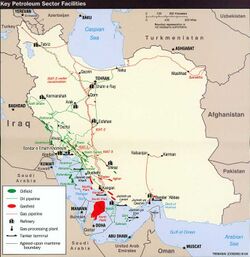
Iran has the world's second largest proved gas reserves after Russia, with 33.6 trillion cubic meters,[574] and the third largest natural gas production after Indonesia and Russia. It also ranks fourth in oil reserves with an estimated 153,600,000,000 barrels.[575][576] It is OPEC's second largest oil exporter. Despite this, Iran spent US$4 billion on fuel imports as of 2005 due to a lack of domestic refining capacity.[577] Oil industry output averaged 4 million barrels per day (640,000 m3/d) in 2005, compared with the peak of six million barrels per day reached in 1974.[578]
In 2004, a large share of Iran's natural gas reserves were untapped. The addition of new hydroelectric stations and the streamlining of conventional coal and oil-fired stations increased installed capacity to 33,000 megawatts. Of that amount, about 75% was based on natural gas, 18% on oil, and 7% on hydroelectric power. In 2004, Iran opened its first wind-powered and geothermal plants, and the first solar thermal plant was to come online in 2009. Iran is the world's third country to have developed GTL technology.[579]
Demographic trends and intensified industrialization have caused electric power demand to grow by 8% per year. The government's goal of 53,000 megawatts of installed capacity by 2010 is to be reached by bringing on line new gas-fired plants, and adding hydropower and nuclear power generation capacity. Iran's first nuclear power plant at Bushire went online in 2011. It is the second nuclear power plant ever built in the Middle East after the Metsamor Nuclear Power Plant in Armenia.[580][581]
Education, science, technology and telecommunications
Science and technology
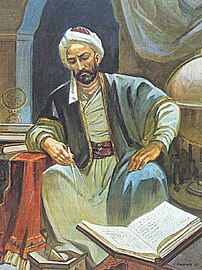
Iran has made considerable advances in science and technology through education and training, despite international sanctions in almost all aspects of research during the past 30 years. In recent years, the growth in Iran's scientific output is reported to be the fastest in the world. In the biomedical sciences, Iran's Institute of Biochemistry and Biophysics has a UNESCO chair in biology.[582] In late 2006, Iranian scientists successfully cloned a sheep by somatic cell nuclear transfer, at the Royan Research Center in Tehran.[583] Stem cell research in Iran is among the top 10 in the world.[584] Iran ranks 15th in the world in nanotechnologies.[585][586][587] Iranian scientists outside Iran have also made some major contributions to science. In 1960, Ali Javan co-invented the first gas laser, and fuzzy set theory was introduced by Lotfi A. Zadeh.[588] Iranian cardiologist Tofigh Mussivand invented and developed the first artificial cardiac pump, the precursor of the artificial heart. Furthering research and treatment of diabetes, the HbA1c was discovered by Samuel Rahbar. A substantial number of papers in string theory are published in Iran.[589] In August 2014, Iranian mathematician Maryam Mirzakhani became the first woman, as well as the first Iranian, to receive the Fields Medal, the highest prize in mathematics.[590]
Education
Education in Iran is highly centralised. K–12 is supervised by the Ministry of Education, and higher education is under the supervision of the Ministry of Science and Technology.The rate of adult literacy (among Iranians of ages 10 to 49) has reached 96% on March 19, 2020;[591] while according to UNESCO it had rated 85.0% in 2008 (up from 36.5% in 1976).[592]
According to the data provided by UNESCO, Iran's literacy rate among people aged 15 years and older was 85.54% as of 2016, with men (90.35%) being significantly more educated than women (80.79%), with the number of illiterate people of the same age amounting to around 8,700,000 of the country's 85 million population.[593] According to this report, Iranian government's expenditure on education amounts to around 4% of the GDP.
The requirement to enter into higher education is to have a high school diploma and pass the Iranian University Entrance Exam (officially known as konkur (کنکور)), which is the equivalent of the SAT and ACT exams of the United States. Many students do a 1–2-year course of pre-university (piš-dānešgāh), which is the equivalent of the GCE A-levels and the International Baccalaureate. The completion of the pre-university course earns students the Pre-University Certificate.[594]
Iran's higher education is sanctioned by different levels of diplomas, including an associate degree (kārdāni; also known as fowq e diplom) delivered in two years, a bachelor's degree (kāršenāsi; also known as lisāns) delivered in four years, and a master's degree (kāršenāsi e aršad) delivered in two years, after which another exam allows the candidate to pursue a doctoral program (PhD; known as doktorā).[595]
According to the Webometrics Ranking of World Universities ((As of January 2017)), Iran's top five universities include Tehran University of Medical Sciences (478th worldwide), the University of Tehran (514th worldwide), Sharif University of Technology (605th worldwide), Amirkabir University of Technology (726th worldwide), and the Tarbiat Modares University (789th worldwide).[596] Iran was ranked 62nd in the Global Innovation Index in 2023, up from 67th in 2020.[597][598] It is widely considered as the nation's most prestigious and leading institution for science, technology, engineering, and mathematics (STEM) fields.
Iran has increased its publication output nearly tenfold from 1996 through 2004, and has been ranked first in terms of output growth rate, followed by China.[599] According to a study by SCImago in 2012, Iran would rank fourth in the world in terms of research output by 2018, if the current trend persists.[600]
In 2009, a SUSE Linux-based HPC system made by the Aerospace Research Institute of Iran (ARI) was launched with 32 cores, and now runs 96 cores. Its performance was pegged at 192 GFLOPS.[601] The Iranian humanoid robot Sorena 2, which was designed by engineers at the University of Tehran, was unveiled in 2010. The Institute of Electrical and Electronics Engineers (IEEE) has placed the name of Surena among the five prominent robots of the world after analyzing its performance.[602]
Iranian Space Agency
Iranian Space Agency (ISA) was established on 28 February 2004. Iran became an orbital-launch-capable nation in 2009,[603] and is one of the 24 founding members of the United Nations Committee on the Peaceful Uses of Outer Space (COPUOS). In 2015, Iran's space program was quietly suspended by President Rouhani following international pressures.[604] It has then been reinvigorated by President Raisi in 2021.[605]
Iran placed its domestically built satellite Omid into orbit on the 30th anniversary of the 1979 Revolution, on 2 February 2009,[606] through its first expendable launch vehicle Safir, becoming the ninth country in the world capable of both producing a satellite and sending it into space from a domestically made launcher.[607] Simorgh's launch in 2016, is the successor of Safir.[608]
On January 20, 2024, Iran launched the Soraya satellite into its highest orbit yet (750 km),[609][610] a new space launch milestone for the country,[611][612][613] and the first time that Iran has successfully placed a satellite in orbits higher than 500 kilometers.[614][615] It was launched by Qaem 100 rocket.[616][617][618]
On January 28, 2024, Iran successfully launched three indigenous satellites, The Mahda, Kayan and Hatef,[619] into orbit using the Simorgh carrier rocket.[620][621][622][623] It was the first time in country's history that it simultaneously sent three satellites into space.[624][625][626] The satellites were sent to a minimum orbit of 450 km (280 miles).[627] One satellite weighing 32 kg (71 pounds) and two nano-satellites of less than 10 kg.[628] The three satellites are designed for testing advanced satellite subsystems, space-based positioning technology, and narrowband communication.[629]
The Iranian nuclear program was launched in the 1950s. Iran is the seventh country to produce uranium hexafluoride, and controls the entire nuclear fuel cycle.[630][631]
Telecommunication
Iran's telecommunications industry is almost entirely state-owned, dominated by the Telecommunication Company of Iran (TCI). Fixed-line penetration in 2004 was relatively well-developed by regional standards, standing at 22 lines per 100 people, higher than Egypt with 14 and Saudi Arabia with 15. Iran had more than 1 mobile phone per inhabitant by 2012.[632]
As of 2020, 70 million Iranians are using high-speed mobile internet. Iran is among the first five countries which have had a growth rate of over 20 percent and the highest level of development in telecommunication.[633] Iran has been awarded the UNESCO special certificate for providing telecommunication services to rural areas. By the end of 2009, Iran's telecom market was the fourth-largest market in the region at $9.2 billion.[634]
Demographics
Iran comprises numerous ethnic and linguistic groups that are unified through a shared Iranian nationality.[635][636]
Iran's population grew rapidly from about 19 million in 1956 to about 85 million by February 2023.[637] However, Iran's fertility rate has dropped significantly in recent years, coming down from a fertility rate of 6.5 per woman to just a little more than 1.7 two decades later,[638][639][640] leading to a population growth rate of about 1.39% as of 2018.[641] Due to its young population, studies project that the growth will continue to slow until it stabilises around 105 million by 2050.[642][643][644]
Iran hosts one of the largest refugee populations, with almost one million refugees,[645] mostly from Afghanistan and Iraq.[646] Since 2006, Iranian officials have been working with the UNHCR and Afghan officials for their repatriation.[647] According to estimates, about five million Iranian citizens have emigrated to other countries, mostly since the 1979 Revolution.[648][649]
According to the Iranian Constitution, the government is required to provide every citizen of the country with access to social security, covering retirement, unemployment, old age, disability, accidents, calamities, health and medical treatment and care services.[650] This is covered by tax revenues and income derived from public contributions.[651]
Languages
The majority of the population speaks Persian, which is also the official language of the country.[2] Others include speakers of several other Iranian languages within the greater Indo-European family and languages belonging to some other ethnicities living in Iran.
The Gilaki and Mazenderani languages are widely spoken in Gilan and Mazenderan, in northern Iran. The Talysh language is also spoken in parts of Gilan, stretching up to the neighboring Republic of Azerbaijan. Varieties of Kurdish are concentrated in the province of Kurdistan and nearby areas. In Khuzestan, several distinct varieties of Persian are spoken. Southern Iran also houses the Luri and Lari languages.
Azerbaijani, the most-spoken minority language in the country,[652] and other Turkic languages and dialects are found in various regions of Iran, especially in the region of Azerbaijan.
Notable minority languages in Iran include Armenian, Georgian, Neo-Aramaic, and Arabic. Khuzi Arabic is spoken by the Arabs in Khuzestan, as well as the wider group of Iranian Arabs. Circassian was also once widely spoken by the large Circassian minority, but, due to assimilation over the many years, no sizable number of Circassians speak the language anymore.[653][654][655][656]
Percentages of spoken language continue to be a point of debate, as many opt that they are politically motivated; most notably regarding the largest and second largest ethnicities in Iran, the Persians and Azerbaijanis. Percentages given by the CIA's World Factbook include 53% Persian, 16% Azerbaijani, 10% Kurdish, 7% Mazenderani and Gilaki, 7% Luri, 2% Turkmen, 2% Balochi, 2% Arabic, and 2% the remainder Armenian, Georgian, Neo-Aramaic, and Circassian.[3]
Ethnic groups
As with the spoken languages, the ethnic group composition also remains a point of debate, mainly regarding the largest and second largest ethnic groups, the Persians and Azerbaijanis, due to the lack of Iranian state censuses based on ethnicity. The CIA's World Factbook has estimated that around 79% of the population of Iran is a diverse Indo-European ethno-linguistic group that comprise speakers of various Iranian languages,[657] with Persians (including Mazenderanis and Gilaks) constituting 61% of the population, Kurds 10%, Lurs 6%, and Balochs 2%. Peoples of other ethnolinguistic groups make up the remaining 21%, with Azerbaijanis constituting 16%, Arabs 2%, Turkmens and other Turkic tribes 2%, and others (such as Armenians, Talysh, Georgians, Circassians, Assyrians) 1%.[3]
The Library of Congress issued slightly different estimates: 65% Persians (including Mazenderanis, Gilaks, and the Talysh), 16% Azerbaijanis, 7% Kurds, 6% Lurs, 2% Baloch, 1% Turkic tribal groups (incl. Qashqai and Turkmens), and non-Iranian, non-Turkic groups (incl. Armenians, Georgians, Assyrians, Circassians, and Arabs) less than 3%. It determined that Persian is the first language of at least 65% of the country's population, and is the second language for most of the remaining 35%.[658][3][659]
Health
Healthcare in Iran is based on three pillars: the public-governmental system, the private sector, and NGOs.[661] The healthcare and medical sector's market value in Iran was almost US$24 billion in 2002. With a population of around 90 million, Iran is one of the most populous countries in West Asia. The country faces the common problem of other young demographic nations in the region, which is keeping pace with growth of an already huge demand for various public services. The young population will soon be old enough to start new families, which will boost the population growth rate and subsequently the need for public health infrastructures and services. Total healthcare spending is expected to rise from $24.3 billion in 2008, to $96 billion by 2017, reflecting the increasing demand on medical services.[662] Total health spending was equivalent to 6% of GDP in Iran in 2017. About 90% of Iranians have some form of health insurance.[663] Iran is also the only country with a legal organ trade. However, the legal character of organ donations is deemed to be a gifting of organs and not their sale and purchase.[664] Iran has been able to extend public health preventive services through the establishment of an extensive Primary Health Care Network. As a result, child and maternal mortality rates have fallen significantly, and life expectancy at birth has risen remarkably. Iran's medical knowledge rank is 17th globally, and 1st in the Middle East and North Africa. In terms of medical science production index, Iran ranks 16th in the world.[665]
Religion
| Religion | Percent | Number |
| Muslim | 99.3989% (90–95% Shia) |
74,682,938 |
| Bahá'í Faith (Estimated) |
0.4% | 300,000 |
| Christian | 0.1566% | 117,704 |
| Zoroastrian | 0.0336% | 25,271 |
| Jewish | 0.0117% | 8,756 |
| Other | 0.0653% | 49,101 |
| Undeclared | 0.3538% | 205,317 |
Twelver Shia Islam is the official state religion, to which about 90% to 95%[667][668][669] of the population adhere. The official motto of the country is "Allahu Akbar", the Islamic takbir.[670][671] About 4% to 8% of the population are Sunni Muslims, mainly Kurds and Baloches. The remaining 2% are non-Muslim religious minorities, including Christians, Zoroastrians, Jews, Baháʼís, Mandaeans, and Yarsanis.[3][672]
A 2020 survey by the World Values Survey found that 96.6% of Iranians believe in Islam.[673] On the other hand, another 2020 survey conducted online by an organization based outside of Iran found a much smaller percentage of Iranians identifying as Muslim (32.2% as Shia, 5.0% as Sunni, and 3.2% as Sufi), and a significant fraction not identifying with any organised religion (22.2% identifying as "None," and some others identifying as atheists, spiritual, agnostics, and secular humanists).[674][675][676][677][678] In 2021, Gamaan, a Dutch research group, conducted an online poll with around 50,000 Iranian respondents, revealing that roughly half reported a change or loss in their religious affiliation. Less than a third adhere to Sh'ia Islam. Despite the ban on proselytizing in the country, there is a noticeable surge in interest in non-Muslim faiths like Zoroastrianism, Christianity and the Baha'i Faith.[679] According to the CIA World Factbook, around 90–95% of Iranian Muslims associate themselves with the Shia branch of Islam, the official state religion, and about 5–10% with the Sunni and Sufi branches.[680][681]

There are a large population of adherents of Yarsanism, a Kurdish indigenous religion, making it the largest (unrecognised) minority religion in Iran. Its followers are mainly Gorani Kurds and certain groups of Lurs. They are based in Kurdistan Province, Kermanshah Province and Lorestan mainly.Christianity, Judaism, Zoroastrianism, and the Sunni branch of Islam are officially recognised by the government and have reserved seats in the Iranian Parliament.[148] Historically, early Iranian religions such as the Proto-Iranic religion and the subsequent Zoroastrianism and Manichaeism were the dominant religions in Iran, particularly during the Median, Achaemenid, Parthian, and Sasanian eras. This changed after the fall of the Sasanian Empire by the centuries-long Islamization that followed the Muslim Conquest of Iran. Iran was predominantly Sunni until the conversion of the country (as well as the people of what is today the neighboring Republic of Azerbaijan) to Shia Islam by order of the Safavid dynasty in the 16th century.[120]
Judaism has a long history in Iran, dating back to the Achaemenid conquest of Babylonia. Although many left in the wake of the establishment of the State of Israel and the 1979 Revolution, about 8,756[683] to 25,000[684] Jewish people live in Iran. Iran has the largest Jewish population in the Middle East outside of Israel.[685]
Around 250,000 to 370,000 Christians reside in Iran,[686][687] and Christianity is the country's largest recognised minority religion.[688] Most are of Armenian background, as well as a sizable minority of Assyrians.[689] A large number of Iranians have converted to Christianity from the predominant Shia Islam.[690][691][692][693]
The Baháʼí Faith is not officially recognized and has been subject to official persecution.[694] According to the United Nations Special Rapporteur on Human Rights in Iran, Baháʼís are the largest non-Muslim religious minority in Iran, with an estimated 350,000 adherents.[695] Since the 1979 Revolution, the persecution of Baháʼís has increased.[694][696][697]
Iranian officials have continued to support the rebuilding and renovation of Armenian churches in Iran. The Armenian Monastic Ensembles of Iran has also received continued support. In 2019, the Iranian government registered the Holy Savior Cathedral, commonly referred to as Vank Cathedral, in the New Julfa district of Isfahan, as a UNESCO World Heritage Site, with significant expenditures for its congregation. Currently three Armenian churches in Iran have been included in the UNESCO World Heritage List.[698][699]
Culture
Art
The art of Iran encompasses many disciplines, including architecture, stonemasonry, metalworking, weaving, pottery, painting, and calligraphy. Iranian works of art show a great variety in style, in different regions and periods.[700] The art of the Medes remains obscure, but has been theoretically attributed to the Scythian style.[701] The Achaemenids borrowed heavily from the art of their neighboring civilizations,[702] but produced a synthesis of a unique style,[703] with an eclectic architecture remaining at sites such as Persepolis and Pasargadae. Greek iconography was imported by the Seleucids, followed by the recombination of Hellenistic and earlier Near Eastern elements in the art of the Parthians,[704] with remains such as the Temple of Anahita and the Statue of the Parthian Nobleman.
By the time of the Sasanians, Iranian art came across a general renaissance.[705] Taq-e-Bostan, Taq-e-Kasra, Naqsh-e-Rostam, and the Shapur-Khwast Castle are among the surviving monuments from the Sasanian period. During the Middle Ages, Sasanian art played a prominent role in the formation of both European and Asian medieval art, which carried forward to the Islamic world, and much of what later became known as Islamic learning—including medicine, architecture, philosophy, philology, and literature—were of Sasanian basis.[706][707][708][709] The Safavid era is known as the Golden Age of Iranian art.[710] Safavid art exerted noticeable influences upon the neighboring Ottomans, the Mughals, and the Deccans, and was also influential through its fashion and garden architecture on 11th–17th-century Europe.
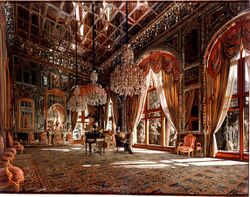
Iran's contemporary art traces its origins back to the time of Kamal-ol-molk,[712] a prominent realist painter at the court of the Qajar dynasty who affected the norms of painting and adopted a naturalistic style that would compete with photographic works. A new Iranian school of fine art was established by Kamal-ol-Molk in 1928,[712] and was followed by the so-called "coffeehouse" style of painting.
Iran's avant-garde modernists emerged by the arrival of new western influences during World War II.[712] The vibrant contemporary art scene originates in the late 1940s, and Tehran's first modern art gallery, Apadana, was opened in September 1949 by painters Mahmud Javadipur, Hosein Kazemi, and Hushang Ajudani.[713] The new movements received official encouragement by the mid-1950s,[712] which led to the emergence of artists such as Marcos Grigorian.[714]
Architecture
The history of architecture in Iran goes back to the seventh millennium BC,[715] and the Iranians made early use of mathematics, geometry and astronomy in their architecture, yielding a tradition with both great structural and aesthetic variety developed out of earlier forms.[716] The guiding motif of Iranian architecture is its cosmic symbolism.[717] Iran ranks seventh among UNESCO's list of countries with the most archaeological ruins and attractions from antiquity.[718]
Weaving
Iran's carpet-weaving has its origins in the Bronze Age and is one of the most distinguished manifestations of Iranian art. Iran is the world's largest producer and exporter of handmade carpets, producing three-quarters of the world's total output and having a share of 30% of world's export markets.[719][720] In 2010, the "traditional skills of carpet weaving" in Fars Province and Kashan were inscribed to the UNESCO Intangible Cultural Heritage List.[721][722][723]
Literature
Iran's oldest literary tradition is that of Avestan, the Old Iranian sacred language of the Avesta, which consists of the legendary and religious texts of Zoroastrianism and the ancient Iranian religion, with its earliest records dating back to the pre-Achaemenid times.[724]
Of the various modern languages used in Iran, Persian, various dialects of which are spoken throughout the Iranian Plateau,[725][726] has the most influential literature. Persian has been dubbed as a worthy language to serve as a conduit for poetry, and is considered one of the four main bodies of world literature.[727] Despite originating from the region of Persis (better known as Persia) in southwestern Iran, the Persian language was used and developed further through Persianate societies in Asia Minor, Central Asia, and South Asia, leaving massive influences on Ottoman and Mughal literatures, among others.
Iran has a number of famous medieval poets, most notably Rumi, Ferdowsi, Hafez, Sa'adi, Omar Khayyam, and Nezami Ganjavi.[728] Iranian literature also inspired writers such as Johann Wolfgang von Goethe, Henry David Thoreau, and Ralph Waldo Emerson.[729][730][731]
World Heritage Sites
Before the Iranian Revolution, Persepolis, Naghsh-e Jahan Square, and Chogha Zanbil were the only three UNESCO-listed monuments.[732] Today, with 27 sites, Iran ranks 10th globally in terms of historical monuments and sites registered on the UNESCO World Heritage list.[733] These include Pasargadae, Golestan Palace, Arg-e Bam, Behistun Inscription, Shahr-e Sukhteh, Susa, Takht-e Soleyman, Hyrcanian forests, the city of Yazd and more. Iran also has 24 Intangible Cultural Heritage, or "Human treasures", which ranks 5th worldwide.[734][735]
Dance
The people of the Iranian plateau have known dance in the forms of music, play, drama or religious rituals and have used instruments like mask, costumes of animals or plants, and musical instruments for rhythm, at least since the 6th millennium BC. Artifacts with pictures of dancers, players or actors were found in many archaeological prehistoric sites in Iran. Genres of dance in Iran vary depending on the area, culture, and language of the local people, and can range from sophisticated reconstructions of refined court dances to energetic folk dances.[736] The population of Iran includes many ethnicities, in addition to numerous Iranian tribal groups which can be found within the borders of modern-day Iran. Each group, region, and historical epoch has specific dance styles associated with it. The earliest researched dance from historic Iran is a dance worshiping Mithra. This dance was to promote vigor in life. Ancient Persian dance was significantly researched by Greek historian from Herodotus in his work Book IX (Calliope), in which he describes the history of Asian empires and Persian wars until 478 BC. Iran was occupied by foreign powers, first Greeks, then Arabs, and then Mongols and in turn political instability and civil wars occurred. Throughout these changes a slow disappearance of heritage dance traditions occurred. The Qajar dynasty had an important influence on Persian dance. In this period, a style of dance began to be called "classical Persian dance". Dancers performed artistic dances in the court of the king for entertainment purposes such as coronations, marriage celebrations, and Norouz celebrations. In the 20th century, the music came to be orchestrated and dance movement and costuming gained a modernistic orientation to the West. In 1928, ballet came to Iran and impacted dance performance, adding a feeling of lightness and more delicate footwork. Artifacts with pictures of dancers, players or actors were found in many archaeological prehistoric sites in Iran, like Tepe Sabz, Ja'far Abad, Chogha Mish, Tall-e Jari,[737] Cheshmeh Ali, Ismaeel Abad, Tal-e bakun, Tepe Sialk, Tepe Musian, tepe Yahya, Shahdad, Tepe Gian, Kul Farah, Susa, Kok Tepe, Cemeteries of Luristan, etc.[738]
Philosophy
Iranian philosophy originates from Indo-European roots, with Zoroaster's reforms having major influences. According to The Oxford Dictionary of Philosophy, the chronology of the subject and science of philosophy starts with the Indo-Iranians, dating this event to 1500 BC.
The Cyrus Cylinder, which is known as "the first charter of human rights", is often seen as a reflection of the questions and thoughts expressed by Zoroaster and developed in Zoroastrian schools of the Achaemenid era.[739][740] The earliest tenets of Zoroastrian schools are part of the extant scriptures of the Zoroastrian religion in Avestan. Among them are treatises such as the Zatspram, Shkand-gumanik Vizar, and Denkard, as well as older passages of the Avesta and the Gathas.[741] Contemporary Iranian philosophy has been limited in its scope by the intellectual repression in the country.[742] Scholars Pavilion is a monument donated by Iran to the United Nations Office at Vienna. The monument architecture is Persian Achaemenid architecture, with the statues of Iranian medieval scholars, Omar Khayyam, Al-Biruni, Rhazes and Avicenna inside the pavilion.[743]
Folklore
Iranian folklore encompasses the folk traditions that have evolved in Greater Iran, which contains numerous folktales, heroes and creatures. Storytelling has an significant presence in Iranian folkrole and culture.[748][749] In classical Iran, minstrels performed for their audiences at royal courts[748] and in public theaters.[748][750] A minstrel was referred to by the Parthians as gōsān in Parthia, and by the Sasanians as huniyāgar in Middle Persian.[748][751] Since the time of the Safavid Empire, storytellers and poetry readers appeared at coffeehouses.[748][752] The beginning of folklore studies can be detected to the 18th century by western scholars.[753][754] Studies by Iranians did not start until the third decade of the 20th century,[755] when strong nationalist feelings coincided among the people, and the studies started to thrive in mid-1970s.[756] After the Iranian Revolution, it took until 1985 to found the MCHTH (Ministry of Cultural Heritage, Tourism and Handicrafts),[757] a now heavily centralized organization, supervising all kinds of cultural activities, encompassing archeology, anthropology and folklore. Its also held the first scientific meeting on anthropology and folklore in 1990.[758]
Mythology
Iranian mythology consists of ancient Iranian folklore and stories of extraordinary beings reflecting on good and evil (Ahura Mazda and Ahriman), actions of the gods, and the exploits of heroes and fabulous creatures. The tenth-century Persian poet, Ferdowsi, is the author of the epic poem known as the Šāhnāme ("Book of Kings"), which is for the most part based on Xwadāynāmag, a Middle Persian compilation of the history of Iranian kings and heroes from mythical times down to the reign of Chosroes II.[761] The Shahnameh is considered the national epic of Iran and draws heavily on the stories and characters of the Zoroastrian tradition, from the texts of the Avesta, the Denkard, the Vendidad and the Bundahishn.
Music
Iran is the apparent birthplace of the earliest complex instruments, dating back to the third millennium BC.[762][better source needed] The use of angular harps have been documented at the sites Madaktu and Kul-e Farah, with the largest collection of Elamite instruments documented at Kul-e Farah.
Xenophon's Cyropaedia mentions a great number of singing women at the court of the Achaemenid Empire. Athenaeus of Naucratis, in his Deipnosophistae, points out to the capture of Achaemenid singing girls at the court of the last Achaemenid king Darius III (336–330 BC) by Macedonian general Parmenion. Under the Parthian Empire, the gōsān (Parthian for "minstrel") had a prominent role in the society.[764][better source needed]
The history of Sasanian music is better documented than the earlier periods and is especially more evident in Avestan texts.[765] By the time of Chosroes II, the Sasanian royal court hosted a number of prominent musicians, namely Azad, Bamshad, Barbad, Nagisa, Ramtin, and Sarkash.
Iranian traditional musical instruments include string instruments such as chang (harp), qanun, santur, rud (oud, barbat), tar, dotar, setar, tanbur, and kamanche, wind instruments such as sorna (zurna, karna) and ney, and percussion instruments such as tompak, kus, daf (dayere), and naqare.
Iran's first symphony orchestra, the Tehran Symphony Orchestra, was founded by Qolam-Hoseyn Minbashian in 1933. It was reformed by Parviz Mahmoud in 1946 and is currently Iran's oldest and largest symphony orchestra. Later, by the late 1940s, Ruhollah Khaleqi founded the country's first national music society and established the School of National Music in 1949.[766]
Iranian pop music has its origins in the Qajar era.[767] It was significantly developed since the 1950s, using indigenous instruments and forms accompanied by electric guitar and other imported characteristics. The emergence of genres such as rock in the 1960s and hip hop in the 2000s also resulted in major movements and influences in Iranian music.[768][769][770][771]
Theater
The earliest recorded representations of dancing figures within Iran were found in prehistoric sites such as Tepe Sialk and Tepe Mūsīān.[772] The oldest Iranian initiation of theater and the phenomena of acting can be traced in the ancient epic ceremonial theaters such as Sug-e Siāvuš ("mourning of Siāvaš"), as well as dances and theater narrations of Iranian mythological tales reported by Herodotus and Xenophon.
Iran's traditional theatrical genres include Baqqāl-bāzi ("grocer play", a form of slapstick comedy), Ruhowzi (or Taxt-howzi, comedy performed over a courtyard pool covered with boards), Siāh-bāzi (in which the central comedian appears in blackface), Sāye-bāzi (shadow play), Xeyme-šab-bāzi (marionette), and Arusak-bāzi (puppetry), and Ta'zie (religious tragedy plays).[773]
Before the 1979 Revolution, the Iranian national stage had become a famous performing scene for known international artists and troupes,[774] with the Roudaki Hall of Tehran constructed to function as the national stage for opera and ballet. Opened on 26 October 1967, the hall is home to the Tehran Symphony Orchestra, the Tehran Opera Orchestra, and the Iranian National Ballet Company, and was officially renamed Vahdat Hall after the 1979 Revolution.
Cinema and animation

A third-millennium BC earthen goblet discovered at the Burnt City, a Bronze Age urban settlement in southeastern Iran, depicts what could possibly be the world's oldest example of animation. The artifact, associated with Jiroft, bears five sequential images depicting a wild goat jumping up to eat the leaves of a tree.[776] The earliest attested Iranian examples of visual representations, however, are traced back to the bas-reliefs of Persepolis, the ritual center of the Achaemenid Empire. The figures at Persepolis remain bound by the rules of grammar and syntax of visual language.[777] The Iranian visual arts reached a pinnacle by the Sasanian era.
The first Iranian filmmaker was probably Mirza Ebrahim (Akkas Bashi), the court photographer of Mozaffar-ed-Din Shah of the Qajar dynasty. Mirza Ebrahim obtained a camera and filmed the Qajar ruler's visit to Europe. Later in 1904, Mirza Ebrahim (Sahhaf Bashi), a businessman, opened the first public movie theater in Tehran.[778] The first Iranian feature film, Abi and Rabi, was a silent comedy directed by Ovanes Ohanian in 1930. The first sounded one, Lor Girl, was produced by Ardeshir Irani and Abd-ol-Hosein Sepanta in 1932.
Iran's animation industry began by the 1950s and was followed by the establishment of the influential Institute for the Intellectual Development of Children and Young Adults in January 1965.[779][780] With the screening of the films Qeysar and The Cow, directed by Masoud Kimiai and Dariush Mehrjui respectively in 1969, alternative films set out to establish their status in the film industry and Bahram Beyzai's Downpour and Nasser Taghvai's Tranquility in the Presence of Others followed soon. Attempts to organise a film festival, which had begun in 1954 within the framework of the Golrizan Festival, resulted in the festival of Sepas in 1969. The endeavors also resulted in the formation of Tehran's World Film Festival in 1973.[781] After the Revolution of 1979, and following the Cultural Revolution, a new age emerged in Iranian cinema, starting with Long Live! by Khosrow Sinai and followed by many other directors, such as Abbas Kiarostami and Jafar Panahi. Kiarostami, an acclaimed Iranian director, planted Iran firmly on the map of world cinema when he won the Palme d'Or for Taste of Cherry in 1997.[782] The continuous presence of Iranian films in prestigious international festivals, such as the Cannes Film Festival, the Venice Film Festival, and the Berlin International Film Festival, attracted world attention to Iranian masterpieces.[783] In 2006, six Iranian films, of six different styles, represented Iranian cinema at the Berlin International Film Festival. Critics considered this a remarkable event in the history of Iranian cinema.[784][785]
Asghar Farhadi, a well-known Iranian director, has received a Golden Globe Award and two Academy Awards, representing Iran for Best Foreign Language Film in 2012 and 2017, with A Separation and The Salesman.[786][787][788]
In 2020, Ashkan Rahgozar's "The Last Fiction", an animated film adaptation of the story of "Zahhak" from the historical identity of Iranians and one of the central tales of Shahnameh by Ferdowsi, became the first representative of Iranian animated cinema in the competition section in both Best Animated Feature and Best Picture categories at 92nd Academy Awards.[789][790][791][792][793][794]
Observances
Iran's official New Year begins with Nowruz, an ancient Iranian tradition celebrated annually on the vernal equinox and described as the Persian New Year.[797] It is enjoyed by people adhering to different religions but is considered a holiday for the Zoroastrians. It was registered on the UNESCO's list of Masterpieces of the Oral and Intangible Heritage of Humanity in 2009.[798][799][800][801] On the eve of the last Wednesday of the preceding year, as a prelude to Nowruz, the ancient festival of Čāršanbe Suri celebrates Ātar ("fire") by performing rituals such as jumping over bonfires and lighting off firecrackers and fireworks.[802][803]
Yaldā, another ancient tradition,[804] commemorates the ancient goddess Mithra and marks the longest night of the year on the eve of the winter solstice (čelle ye zemestān; usually falling on 20 or 21 December),[805][806] during which families gather together to recite poetry and eat fruits.[807][808] In some regions of the provinces of Mazanderan and Markazi,[809][810][811][812] there is also the midsummer festival of Tirgān,[813] which is observed on Tir 13 (2 or 3 July) as a celebration of water.[814][815]
Alongside the ancient Iranian celebrations, Islamic annual events such as Ramezān, Eid e Fetr, and Ruz e Āšurā are marked by the country's large Muslim population, Christian traditions such as Noel,[816] Čelle ye Ruze, and Eid e Pāk[817] are observed by the Christian communities, Jewish traditions such as Purim,[818] Hanukā,[819] and Eid e Fatir (Pesah)[820][821] are observed by the Jewish communities, and Zoroastrian traditions such as Sade[822] and Mehrgān are observed by the Zoroastrians.
Public holidays
Iran's official calendar is the Solar Hejri calendar, beginning at the vernal equinox in the Northern Hemisphere, which was first enacted by the Iranian Parliament on 31 March 1925.[823] Each of the 12 months of the Solar Hejri calendar correspond with a zodiac sign, and the length of each year is absolutely solar.[823] The months are named after the ancient Iranian months,[823] namely Farvardin (Fravaši), Ordibehešt (Aša Vahišta), Xordād (Haurvatāt), Tir (Tištrya), Amordād (Amərətāt), Šahrivar (Xšaθra Vairya), Mehr (Miθra), Ābān (Āpō), Āzar (Ātar), Dey (Daθuš), Bahman (Vohu Manah), and Esfand (Spəntā Ārmaiti).
Alternatively, the Lunar Hejri calendar is used to indicate Islamic events, and the Gregorian calendar remarks the international events.
Legal public holidays based on the Iranian solar calendar include the cultural celebrations of Nowruz (Farvardin 1–4; 21–24 March) and Sizdebedar (Farvardin 13; 2 April), and the political events of Islamic Republic Day (Farvardin 12; 1 April), the death of Ruhollah Khomeini (Khordad 14; 4 June), the Khordad 15 event (Khordad 15; 5 June), the anniversary of the 1979 Revolution (Bahman 22; 10 February), and Oil Nationalization Day (Esfand 29; 19 March).[824]
Lunar Islamic public holidays include Tasua (Muharram 9), Ashura (Muharram 10), Arba'een (Safar 20), the death of Muhammad (Safar 28), the death of Ali al-Ridha (Safar 29 or 30), the birthday of Muhammad (Rabi-al-Awwal 17), the death of Fatimah (Jumada-al-Thani 3), the birthday of Ali (Rajab 13), Muhammad's first revelation (Rajab 27), the birthday of Muhammad al-Mahdi (Sha'ban 15), the death of Ali (Ramadan 21), Eid al-Fitr (Shawwal 1–2), the death of Ja'far al-Sadiq (Shawwal 25), Eid al-Qurban (Zulhijja 10), and Eid al-Qadir (Zulhijja 18).[824]
Cuisine
Iranian cuisine includes a wide range of main dishes, including various types of kebab, pilaf, stew (khoresh), soup and āsh, and omelette. Lunch and dinner meals are commonly accompanied by side dishes such as plain yogurt or mast-o-khiar, sabzi, salad Shirazi, and torshi, and might follow dishes such as borani, Mirza Qasemi, or kashk e bademjan as the starter.
In Iranian culture, tea (čāy) is widely consumed.[828][829] Iran is the world's seventh major tea producer,[830] and a cup of tea is typically the first thing offered to a guest.[831] One of Iran's most popular desserts is the falude,[832] consisting of vermicelli in a rose water syrup, which has its roots in the fourth century BC.[833] There is also the popular saffron ice cream, known as Bastani Sonnati ("traditional ice cream"),[834] which is sometimes accompanied with carrot juice.[835] Iran is also famous for its caviar.[836]
Sports
Iran is most likely the birthplace of polo,[837][838] locally known as čowgān, with its earliest records attributed to the ancient Medes.[839] Freestyle wrestling is traditionally considered the national sport of Iran, and the national wrestlers have been world champions on many occasions. Iran's traditional wrestling, called košti e pahlevāni ("heroic wrestling"), is registered on UNESCO's Intangible Cultural Heritage list.
Being a mountainous country, Iran is a venue for skiing, snowboarding, hiking, rock climbing,[840] and mountain climbing.[841][842] It is home to several ski resorts, the most famous being Tochal, Dizin, and Shemshak, all within one to three hours traveling from the capital city Tehran.[843] The resort of Tochal, located in the Alborz mountain rage, is the world's fifth-highest ski resort (3,730 m or 12,238 ft at its highest station). Dizin is the largest Iranian ski resort, and its officially granted the title by FIS for its capability in administering official and international competitions.[844]
Iran's National Olympic Committee was founded in 1947. Wrestlers and weightlifters have achieved the country's highest records at the Olympics. In September 1974, Iran became the first country in West Asia to host the Asian Games.[845][846][847]
Football has been regarded as the most popular sport in Iran, with the men's national team having won the Asian Cup on three occasions. The men's national team has maintained its position as Asia's best team, ranking first in Asia and 22nd in the world according to the FIFA World Rankings ((As of September 2021)).[848] The Azadi Stadium in Tehran is the 1st largest association football stadium in Western Asia, and it was on the list of top-20 best stadiums in the world.[849] The Guardian also regarded the Azadi as one of the world's biggest football stadiums.[850]
Volleyball is the second most popular sport in Iran.[851][852] Having won the 2011 and 2013 Asian Men's Volleyball Championships, the men's national team is currently the strongest team in Asia, and ranks eighth in the FIVB World Rankings ((As of July 2017)).
Basketball is also popular,[853] with the men's national team having won three Asian Championships since 2007.
In 2016, Iran made global headlines for international female champions boycotting tournaments in Iran in chess (U.S. Woman Grandmaster Nazí Paikidze)[854][855] and in shooting (Indian world champion Heena Sidhu),[856] as they refused to enter a country where they would be forced to wear a hijab.
Museums
The National Museum of Iran in Tehran, known as the mother of all the museums in Iran,[857] is the country's most important cultural institution. As the first and biggest museum in Iran, the institution is formed of two museums; the Museum of Ancient Iran, which exhibits over 3 million works (300,000 on display) dating back to prehistory, ancient and medieval Iranian eras, and the Museum of the Islamic Era, exhibiting over 1,500 works from the Islamic era of Iran such as Ilkanids, Seljuks, Timurids, Safavids, Qajars and more. National Museum of Iran is the world's most important museum in terms of preservation, display and research of archaeological collections of Iran,[858] and ranks as one of the few most prestigious museums globally in terms of volume, diversity and quality of its monuments.[859]
As a nation with rich historical and cultural legacy, there are many other popular museums across the country such as the Golestan Palace (UNESCO World Heritage Site), The Treasury of National Jewels, Reza Abbasi Museum, Tehran Museum of Contemporary Art, Sa'dabad Complex, The Carpet Museum, Abgineh Museum, Pars Museum, Azerbaijan Museum, Hegmataneh Museum, Susa Museum and more.
In 2019, around 25 million people visited the museums of the country.[860][861]
Media
According to the Press Freedom Index, Iran ranks 174th out of 180 countries as of 2021.[862][863] The Ministry of Culture and Islamic Guidance is responsible for the cultural policy, including activities regarding communications and information.[864] Most of the newspapers published in Iran are in Persian, the country's official language. The country's most widely circulated periodicals are based in Tehran, among which are Etemad, Ettela'at, Kayhan, Hamshahri, Resalat, and Shargh.[542] Tehran Times, Iran Daily, and Financial Tribune are among English-language newspapers based in Iran.
Since the 1979 Revolution, Iran's largest media corporation is the Islamic Republic of Iran Broadcasting (IRIB).[542] Despite the restrictions on non-domestic television, about 65% of the residents of Tehran and about 30 to 40% of residents outside the capital access worldwide television channels through satellite dishes, although observers state that the figures are likely to be higher.[865][866]
According to Internet World Stats, (As of 2017), around 69.1% of the population are Internet users.[867] Iran ranks 17th among countries by number of Internet users. Google Search is Iran's most widely used search engine and Instagram is the most popular online social networking service.[868] Direct access to many worldwide mainstream websites has been blocked in Iran, including Facebook, which has been blocked since 2009 due to the organization of anti-governmental protests on the website.[869] However, (As of 2017), Facebook has around 40 million subscribers based in Iran (48.8% of the population) who use virtual private networks and proxy servers to access the website.[867] About 90% of Iran's e-commerce takes place on the Iranian online store Digikala, which has around 750,000 visitors per day and more than 2.3 million subscribers and is the most visited online store in the Middle East.[870][868]
Fashion and clothing
The exact date of the emergence of weaving in Iran is not yet known, but it is likely to coincide with the emergence of civilization. Ferdowsi and many historians have considered Keyumars to be first to use animals' skin and hair as clothing, while others propose Hushang.[871] Ferdowsi considers Tahmuras to be a kind of textile initiator in Iran. The clothing of ancient Iran took an advanced form, and the fabric and color of clothing became very important. Depending on the social status, eminence, climate of the region and the season, Persian clothing during the Achaemenian period took various forms. This clothing, in addition to being functional, had an aesthetic role.[871]
See also
Explanatory notes
References
Bibliography
- Template:Cite book
- Template:Cite book
- Iran: A Country Study. 2008, Washington, DC: Library of Congress, 354 pp.
- Template:Cite encyclopedia
- Template:Cite encyclopedia
- Template:Cite book
- Template:Cite book
- Template:Cite book
- Template:Cite encyclopedia
- Template:Cite encyclopedia
- Template:Cite book
External links
- The e-office of the Supreme Leader of Iran
- The President of Iran
- Iran.ir Template:In lang
- Iran. The World Factbook. Central Intelligence Agency.
- Template:Curlie


